Australia is home to some of the most unique and stunning birds in the world. From majestic birds of prey to colorful parrots and dazzling songbirds, Australia is an ideal destination for bird enthusiasts.
The country boasts more than 800 species of birds, including some that are found nowhere else on Earth. Australia’s diverse climates and habitats provide an ideal habitat for some of the most fascinating birds in the world, making it the perfect destination for birdwatching.
1. Parrots
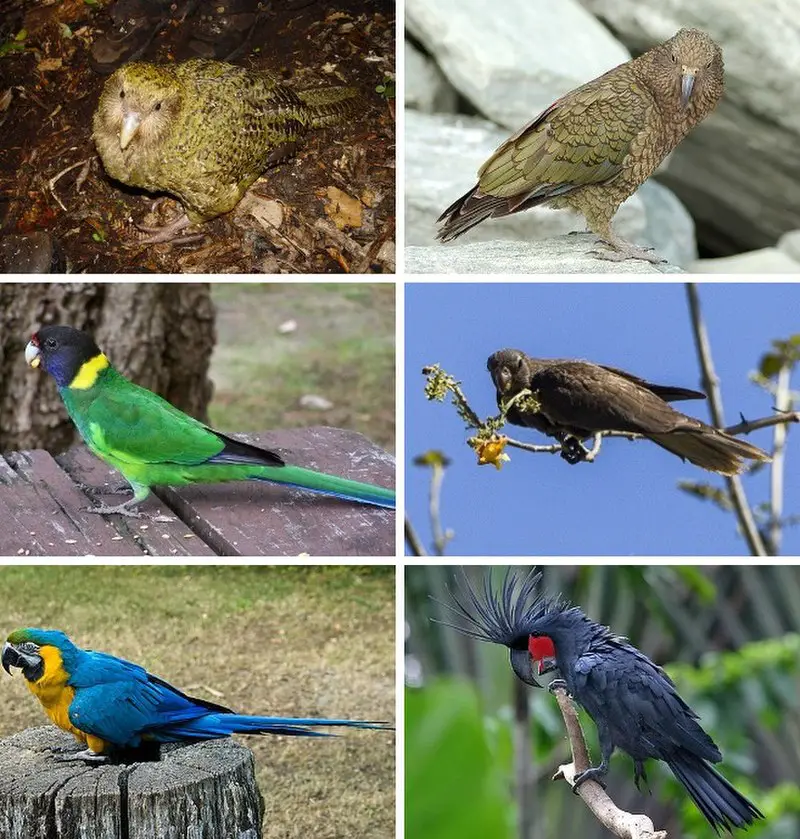
Parrots are a diverse group of birds, found in tropical and subtropical regions. They make up the order Psittaciformes, which is divided into three superfamilies: “true” parrots (Psittacoidea), cockatoos (Cacatuoidea) and New Zealand Parrots (Strigopoidea).
Many species have brightly colored feathers that can be red, yellow or blue. Their strong curved bills allow them to feed on fruits, nuts and seeds.
Parrot behavior ranges from playful to aggressive depending on their environment and socialization with humans.
Some even learn human words. As beloved pets they bring joy to many households around the world though it’s important for owners to understand how best to care for these intelligent creatures so as not to cause distress or harm.
Scientific classification:
| Kingdom | Animalia |
| Phylum | Chordata |
| Class | Aves |
| Clade | Psittacopasserae |
| Order | Psittaciformes Wagler, 1830 |
Also Featured In: Birds That Live in the Jungle, Famous Paintings Birds
2. Cockatoos
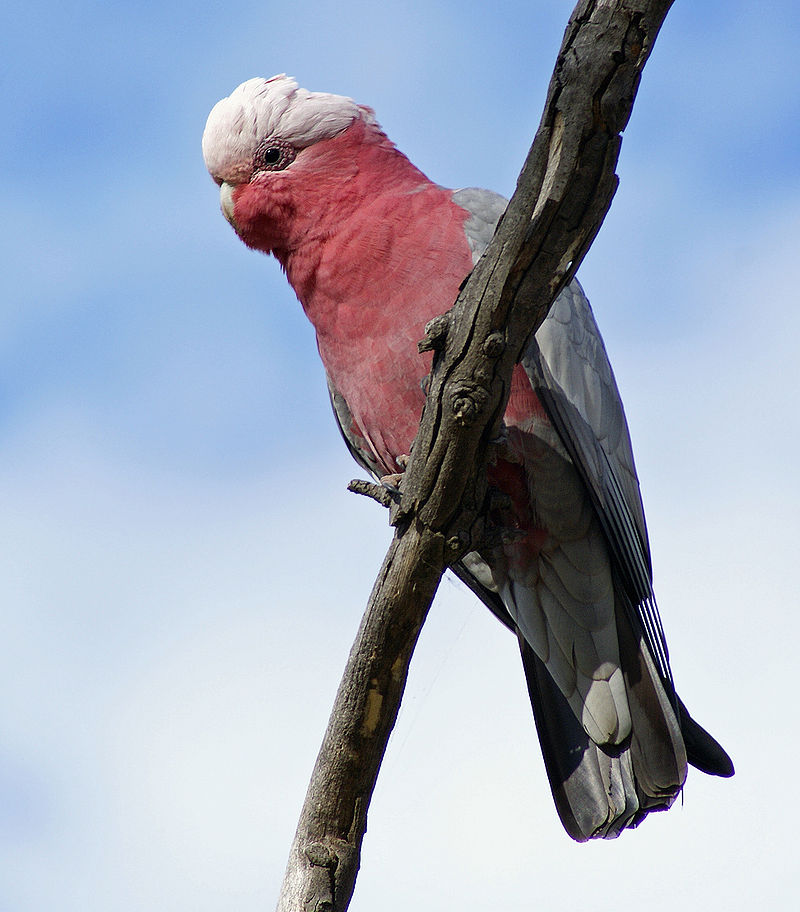
Cockatoos are a family of parrots native to Australasia. They have distinctive crests, curved beaks and loud calls that can easily be heard from long distances.
Most cockatoo species are highly socialized and form large flocks in the wild for protection against predators or extreme weather conditions.
Cockatoos come in various sizes, with some reaching up to 90 cm (35 inches) tall from head to tail tip.
The plumage on their wings is also incredibly vibrant and they often display beautiful patterns such as stripes or spots across their feathers.
Their diet consists mainly of seeds, nuts, fruits & vegetables but they will occasionally hunt insects as well.
In captivity, these birds require lots of attention if kept as pets; however when given proper care they can make loyal companions who love interacting with people throughout the day.
Scientific classification:
| Kingdom | Animalia |
| Phylum | Chordata |
| Class | Aves |
| Order | Psittaciformes |
| Superfamily | Cacatuoidea |
| Family | Cacatuidae G. R. Gray 1840 |
Also Featured In: Case Birds that Live in with Us,
3. Honeyeaters
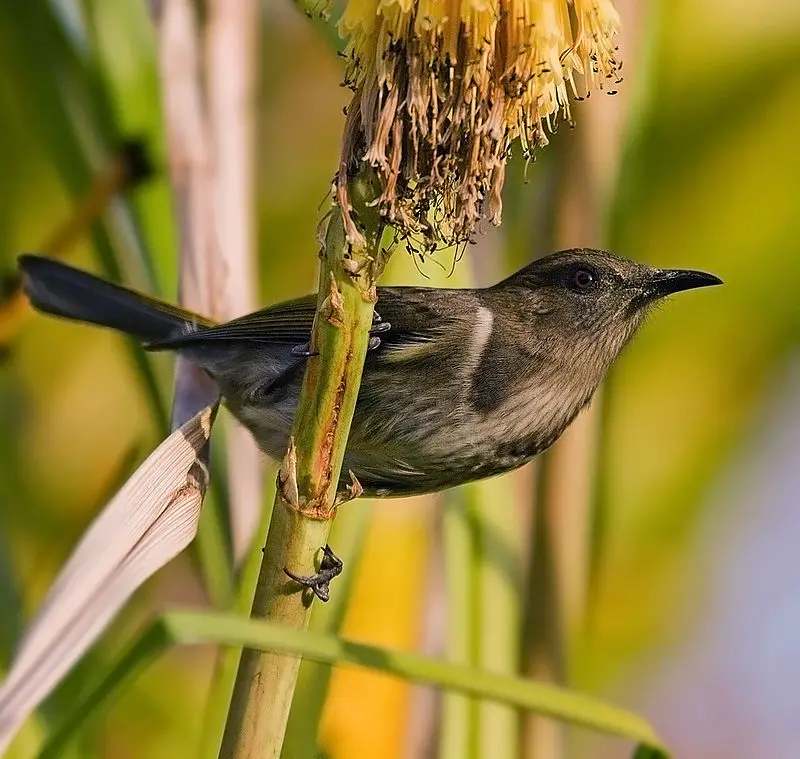
Honeyeaters are a unique and diverse family of birds, with species ranging in size from small to medium.
Found mainly in Australia and New Guinea, they can also be found as far east as Samoa and Tonga, or on islands such as Wallacea north or west of New Guinea.
Honeyeaters feed mainly on nectar but will consume insects if necessary for additional nutrition. They have specialized brush-like tongues that help them extract the nectar efficiently.
Their bright colours tend to make them stand out among other bird families making them easy to spot when out observing wildlife.
Scientific classification:
| Kingdom | Animalia |
| Phylum | Chordata |
| Class | Aves |
| Order | Passeriformes |
| Superfamily | Meliphagoidea |
| Family | Meliphagidae Vigors, 1825 |
Also Featured In: Birds that Charles Darwin Studied, Guam Birds You Need to See
4. Emu
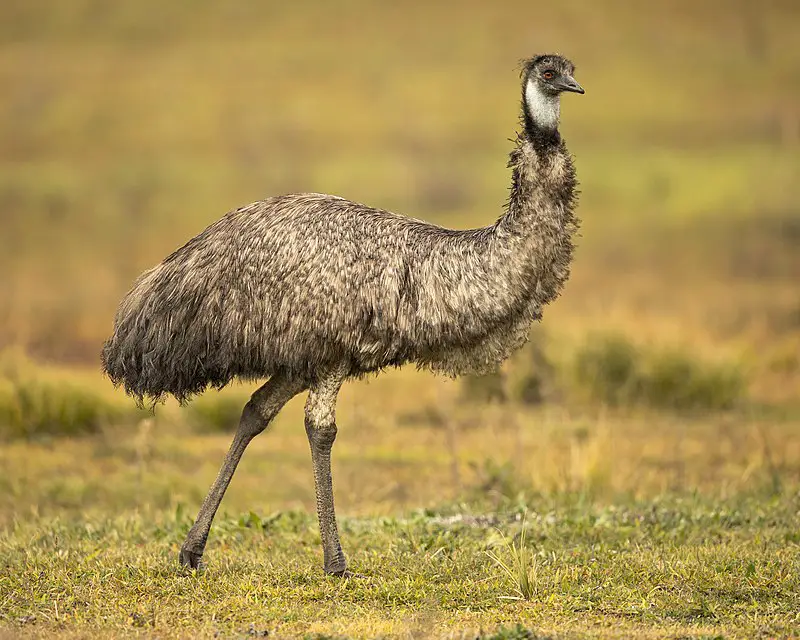
The Emu is a large bird native to Australia, and the only living species of its genus. It stands as the second-tallest living bird in the world after ostriches.
These birds are largely flightless but can run fast over short distances with their long legs, allowing them to escape from predators easily.
They have brown feathers that help camouflage them on open grasslands and wooded areas they inhabit throughout mainland Australia.
Unfortunately, three subspecies of emus on Kangaroo Island, King Island and Tasmania became extinct soon after European settlers arrived in Australia due to hunting or habitat destruction caused by human activities such as logging or agriculture development.
Despite this decline in population numbers, these impressive creatures continue to thrive across much of continental Australia today.
Scientific classification:
| Kingdom | Animalia |
| Phylum | Chordata |
| Class | Aves |
| Infraclass | Palaeognathae |
| Order | Casuariiformes |
| Family | Casuariidae |
| Genus | Dromaius |
| Species | D. novaehollandiae |
Also Featured In: Birds You’ll Find in Zoo, Most Common Birds in Oceania
5. Australian Magpie
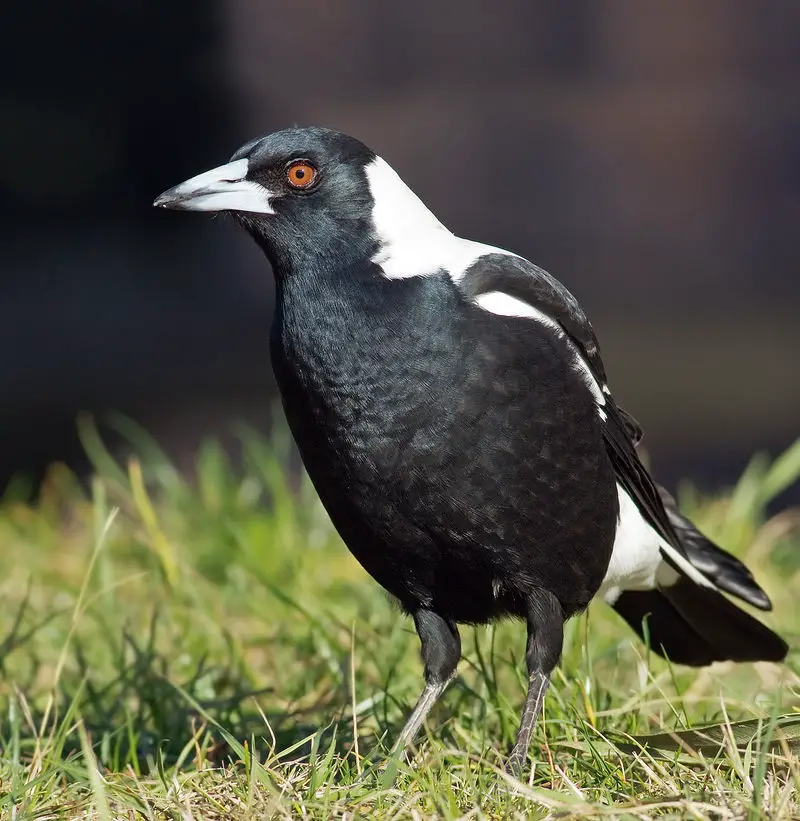
The Australian magpie is a beautiful passerine bird native to Australia and southern New Guinea.
It has distinctive black and white plumage, with males having more brightly coloured feathers than females.
The species is part of the Artamidae family, so it’s closely related to the Black Butcherbird (Melloria quoyi). Nine different subspecies have been recognised which vary slightly in size and colouring.
Magpies are omnivorous birds meaning they eat both plants and animals; their diet consists mainly of insects, small reptiles and amphibians as well as some grains such as wheat or oats.
They also enjoy drinking from pools of water on hot days. In general these birds display high intelligence when compared to other avian species – able to mimic human speech patterns quite accurately even in captivity.
Overall this majestic creature deserves our appreciation for its beauty, loyalty and fascinating behaviour.
Scientific classification:
| Kingdom | Animalia |
| Phylum | Chordata |
| Class | Aves |
| Order | Passeriformes |
| Family | Artamidae |
| Genus | Gymnorhina Gray, GR, 1840 |
| Species | G. tibicen |
Also Featured In: Birds that Live around Brisbane, Birds that Live around Victoria
6. Songbirds
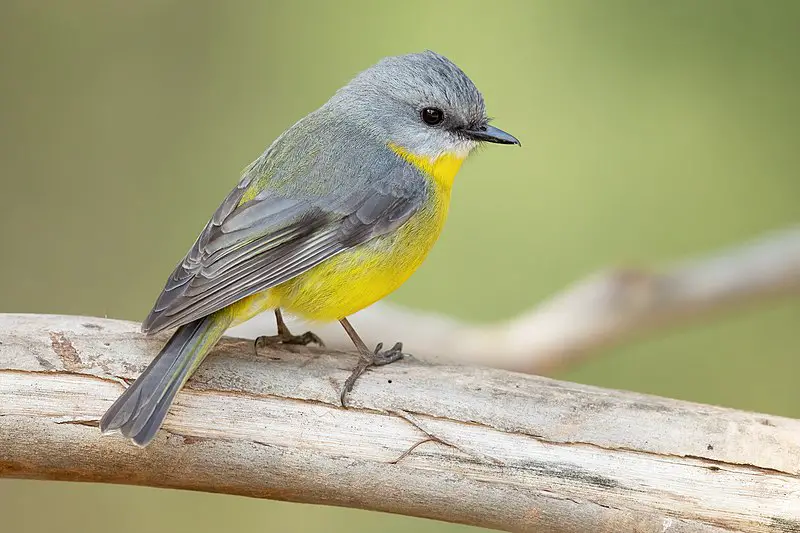
Songbirds are a special suborder of perching birds found all over the world. These beautiful creatures have intricate vocal organs that allow them to produce elaborate bird songs, making them stand out from other species.
With around 5,000 different types of songbird in existence, they come in various sizes and colors with complex feathers adding to their beauty.
Songbirds play an important role in eco-systems as they help disperse seeds by eating fruit and insects which act as agents for pollination.
Their presence also serves to attract more biodiversity into areas where these delicate animals live, creating vibrant habitats full of life.
Scientific classification:
| Kingdom | Animalia |
| Phylum | Chordata |
| Class | Aves |
| Order | Passeriformes |
| Clade | Eupasseres |
| Suborder | Passeri Linnaeus, 1758 |
7. Laughing Kookaburra
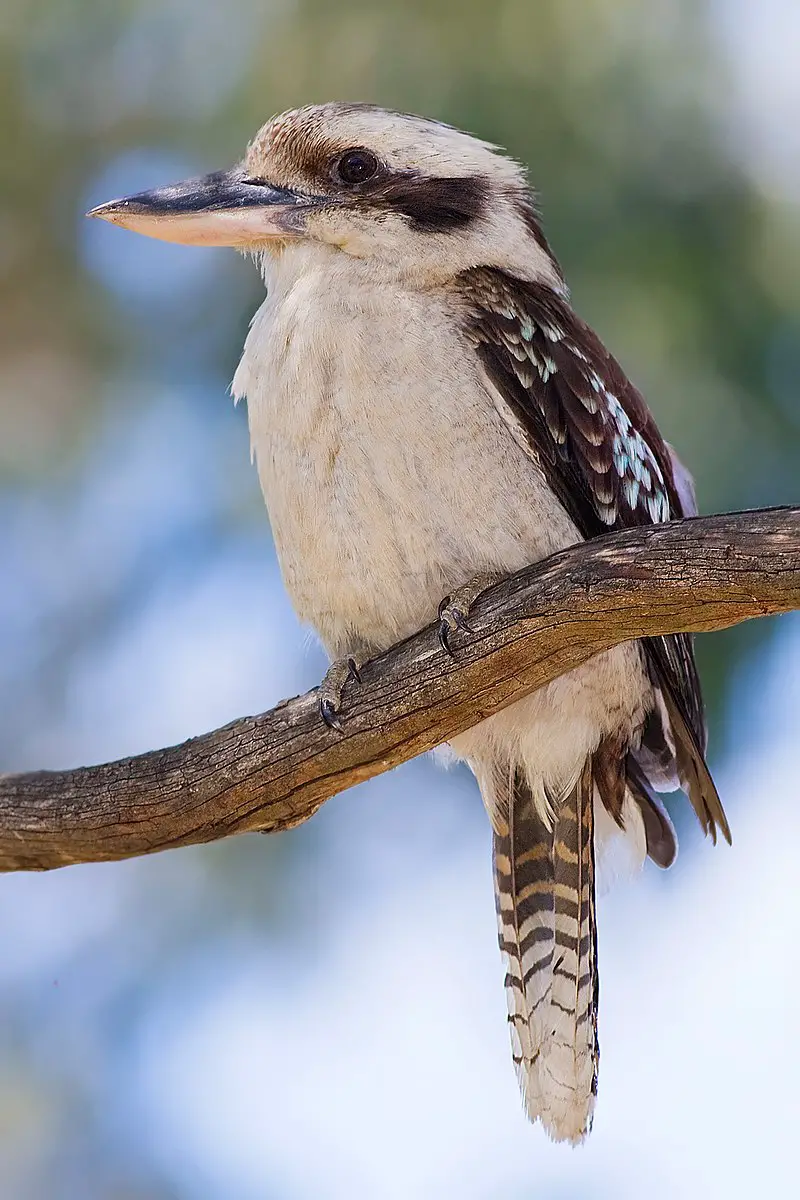
The Laughing Kookaburra is a beautiful bird with distinct features. It has a whitish head and brown eye-stripe, along with an upper body that is predominantly dark brown.
On its wings are mottled light blue patches which make it stand out even more. Its underparts are cream white while its tail is barred in rufous and black colours.
Male and female birds have the same plumage, making them easy to identify as belonging to this species of kingfisher subfamily Halcyoninae.
They can be found living around woodlands or open forests throughout eastern Australia, where they feed on small reptiles, insects or amphibians by swooping down from a perch above them before carrying their prey back up again for consumption.
The sound of their loud distinctive call – “koo-kaa-brrr” – brings joy to many Australians who appreciate these wonderful creatures inhabiting our land.
Scientific classification:
| Kingdom | Animalia |
| Phylum | Chordata |
| Class | Aves |
| Order | Coraciiformes |
| Family | Alcedinidae |
| Subfamily | Halcyoninae |
| Genus | Dacelo |
| Species | D. novaeguineae |
Also Featured In: Queensland Birds You Should Know, South Australian Birds
8. Rainbow Lorikeet
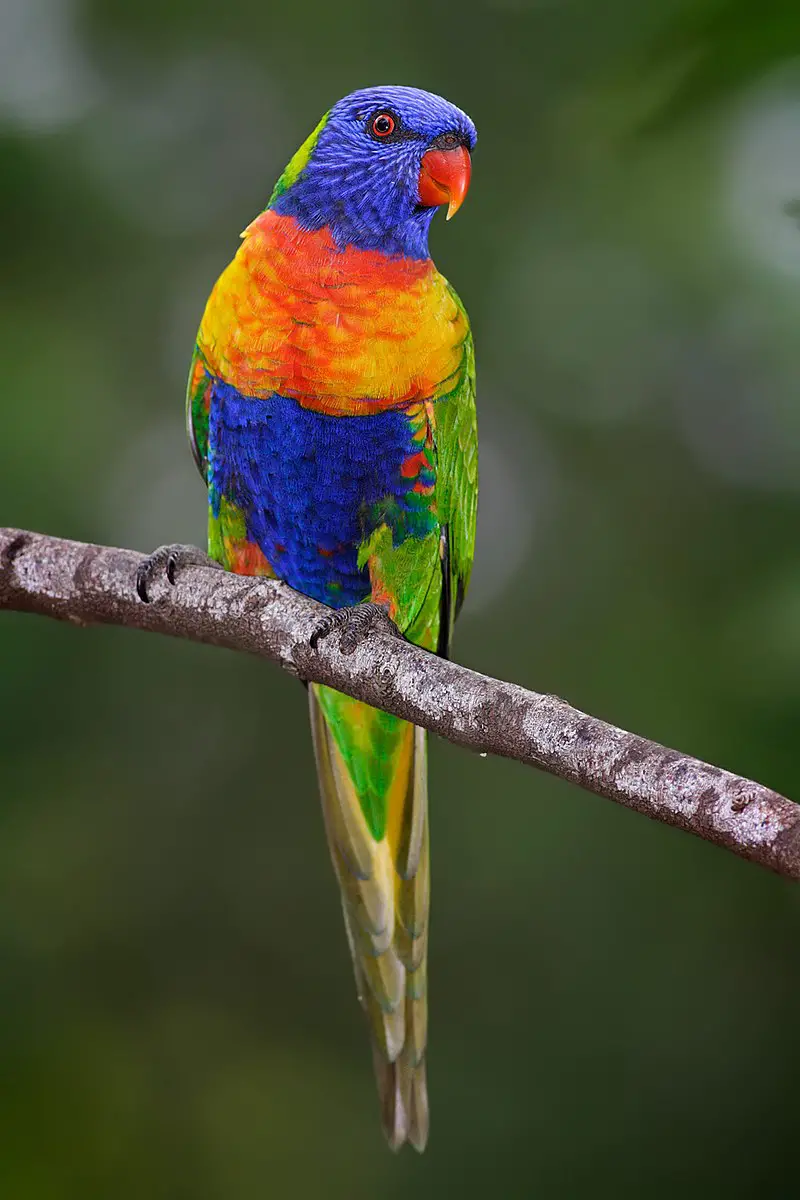
The Rainbow Lorikeet is a brightly coloured parrot native to Australia. It inhabits rainforests, coastal bushlands and woodland areas along the eastern seaboard from northern Queensland to South Australia.
These birds have an unmistakable bright rainbow plumage of blue, red and yellow feathers which make them easy to recognise in their natural environment.
They are also known for their distinctive call – often described as sounding like ‘kikiki-kyu’.
Six related species were once considered subspecies of the Rainbow Lorikeet but these days they are recognised separately due to differences in size, colouration and behaviour.
Despite being introduced elsewhere such as New Zealand, Hawaii or California they remain largely confined within their original range in Australia – where they can be seen soaring through the air or drinking nectar from flowers with its long tongue.
Scientific classification:
| Kingdom | Animalia |
| Phylum | Chordata |
| Class | Aves |
| Order | Psittaciformes |
| Family | Psittaculidae |
| Genus | Trichoglossus |
| Species | T. moluccanus |
Also Featured In: Aviary Birds You Should Know, Birds that Live Near Adelaide
9. Galah
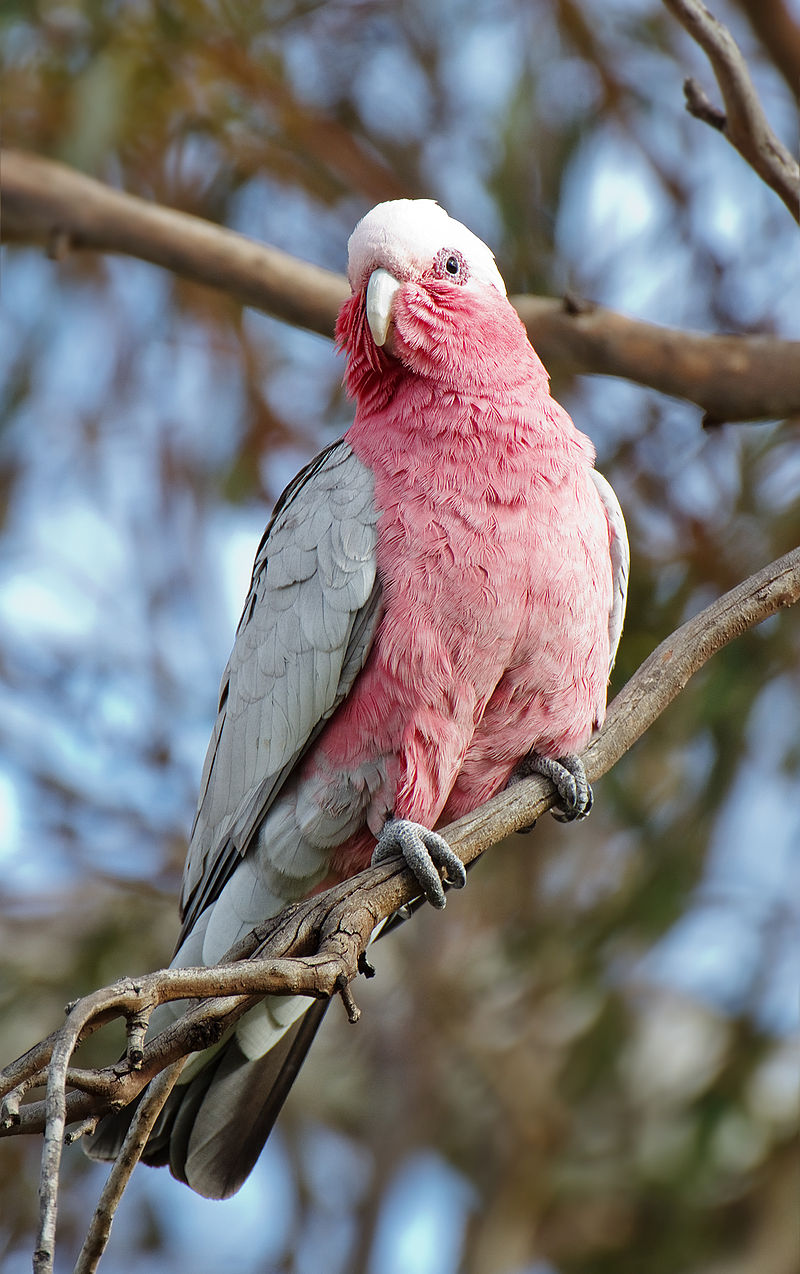
The Galah is a striking bird, easily identified by its distinctive pink and grey plumage. It belongs to the cockatoo family and is found throughout Australia.
With its loud call, it’s not hard to spot this vibrant bird in both rural and urban settings. They are also known as rose-breasted cockatoos due to their bright feathers on their chest.
These birds form strong relationships with each other, living together in pairs or small groups while they look for food among grasslands or open woodlands.
Their diet consists of seeds, fruits, buds & flowers making them valuable contributors to ecosystems across the country.
Scientific classification:
| Kingdom | Animalia |
| Phylum | Chordata |
| Class | Aves |
| Order | Psittaciformes |
| Family | Cacatuidae |
| Genus | Eolophus Bonaparte, 1854 |
| Species | E. roseicapilla |
Also Featured In: Sydney Birds You Need to See, New South Wales Birds You Need to See
10. Kookaburra
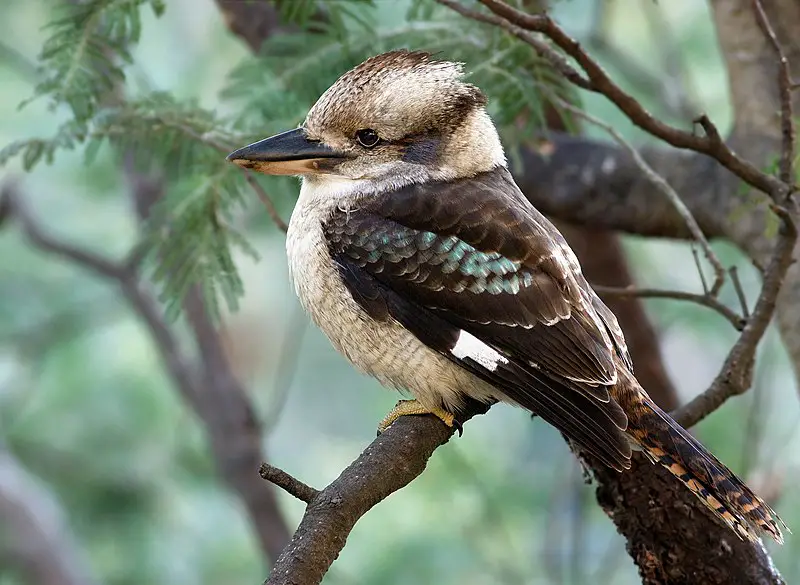
Kookaburras are the kingfishers of Australia and New Guinea. They measure between 28-47 cm in length, weighing around 300g. These birds have a distinctive call that sounds like loud laughter – this is why they’re called ‘Laughing Kookaburra’.
It’s become a popular sound effect for many situations involving Australia. Their vocalizations can be heard from up to 2km away and consist of both single notes or repetitive series.
They eat small insects, lizards, frogs, snakes and other small animals as well as sometimes fruits too.
In captivity their lifespans can reach over 20 years old but usually not more than 10 in the wild due to predators such as cats and foxes preying on them.
Scientific classification:
| Kingdom | Animalia |
| Phylum | Chordata |
| Class | Aves |
| Order | Coraciiformes |
| Family | Alcedinidae |
| Subfamily | Halcyoninae |
| Genus | Dacelo Leach, 1815 |
11. Australian King Parrot
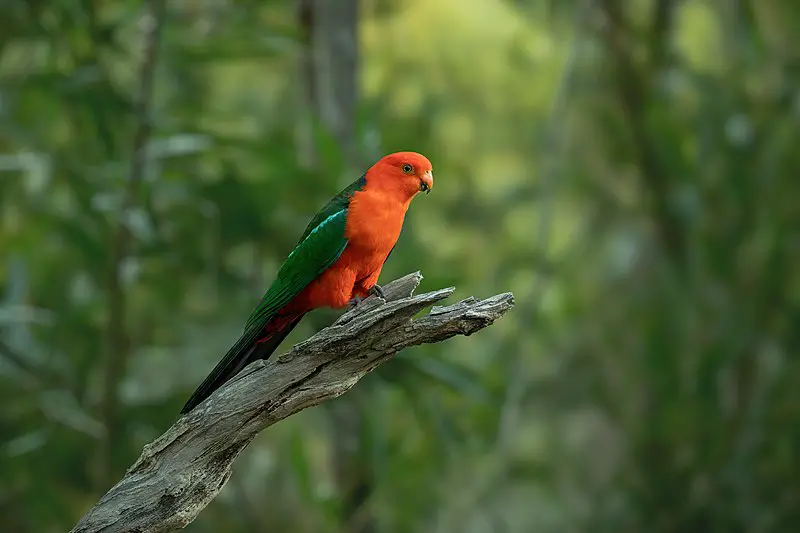
The Australian king parrot is a colourful bird endemic to eastern Australia. It lives in humid, heavily forested areas of the continent including eucalyptus woodlands and subtropical and temperate rainforest.
The King Parrot has an unmistakable green back with red underparts for males, females show more muted colours but still have a bright red belly.
These birds feed on fruits and seeds gathered from trees or shrubs such as Eucalyptus, Acacia or Lillipilli.
They are also commonly seen scavenging for food near roadsides where people often leave scraps behind – so it pays to be careful if you’re driving through any areas they inhabit.
Despite their small size these birds are quite vocal making them easily noticed by both humans and other wildlife alike.
Scientific classification:
| Kingdom | Animalia |
| Phylum | Chordata |
| Class | Aves |
| Order | Psittaciformes |
| Family | Psittaculidae |
| Genus | Alisterus |
| Species | A. scapularis |
Also Featured In: Birds that Live in Sunshine Coast,
12. Budgerigar
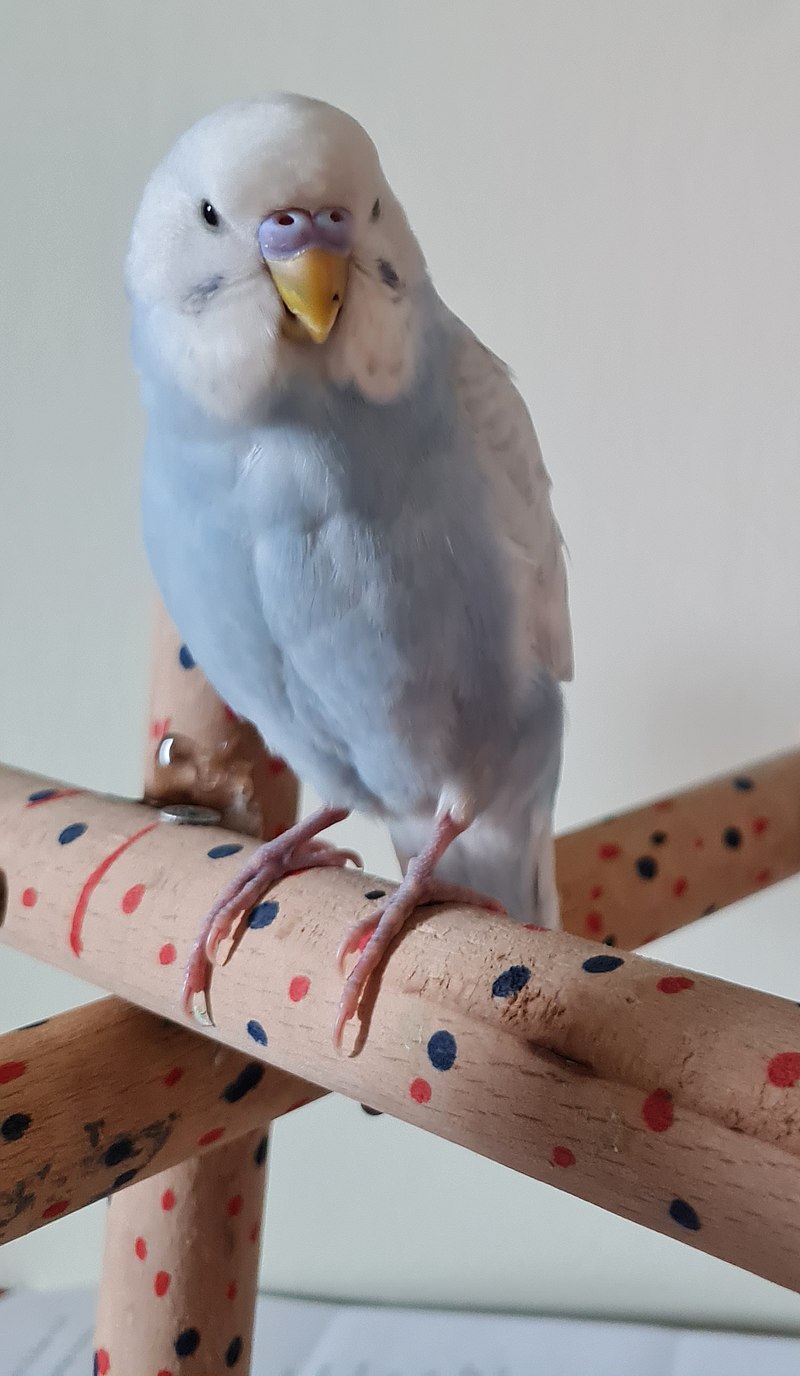
The Budgerigar is a small and beautiful parrot, commonly known as the common parakeet or shell parakeet. It has an average length of 18 cm with a long tail and primarily green-yellow coloration along its body.
Black stripes can be found on their wings and cheeks while they have white rings around their eyes giving them a unique look.
These birds are mainly seed eaters but also love fruits, vegetables, nuts and other grains in captivity.
They are highly social creatures that live in large flocks in the wild but enjoy companionship when kept as pets too.
Their ability to mimic human speech makes them great conversation partners for those living alone who need some company.
Scientific classification:
| Kingdom | Animalia |
| Phylum | Chordata |
| Class | Aves |
| Order | Psittaciformes |
| Family | Psittaculidae |
| Subfamily | Loriinae |
| Tribe | Melopsittacini |
| Genus | Melopsittacus Gould, 1840 |
| Species | M. undulatus |
Also Featured In: Pet Birds that Live in India, Small Birds that Live in New South Wales
13. Bowerbirds
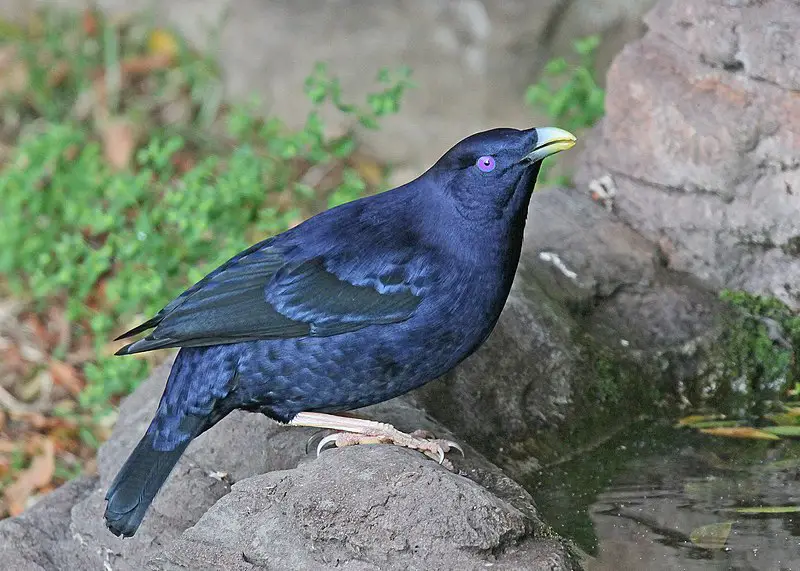
Bowerbirds are a fascinating group of birds belonging to the Ptilonorhynchidae family. They have an incredible courtship display, where males build elaborate structures and decorate them with bright objects in order to attract a mate.
There are 27 species found within 8 genera, ranging from 22 cm (8.7 in) long Golden Bowerbird to larger passerines weighing up to 70 g.
Their diet consists mainly of fruit and insects as well as nectar on occasion depending upon their habitat range.
These beautiful creatures can be found inhabiting rainforests across Australia, New Guinea and Indonesia – all areas that boast lush vegetation for these birds’ unique nesting requirements.
Scientific classification:
| Kingdom | Animalia |
| Phylum | Chordata |
| Class | Aves |
| Order | Passeriformes |
| Clade | Eupasseres |
| Suborder | Passeri |
| Family | Ptilonorhynchidae GR Gray, 1841 |
Also Featured In: Flocks Birds around Us,
14. Southern Cassowary
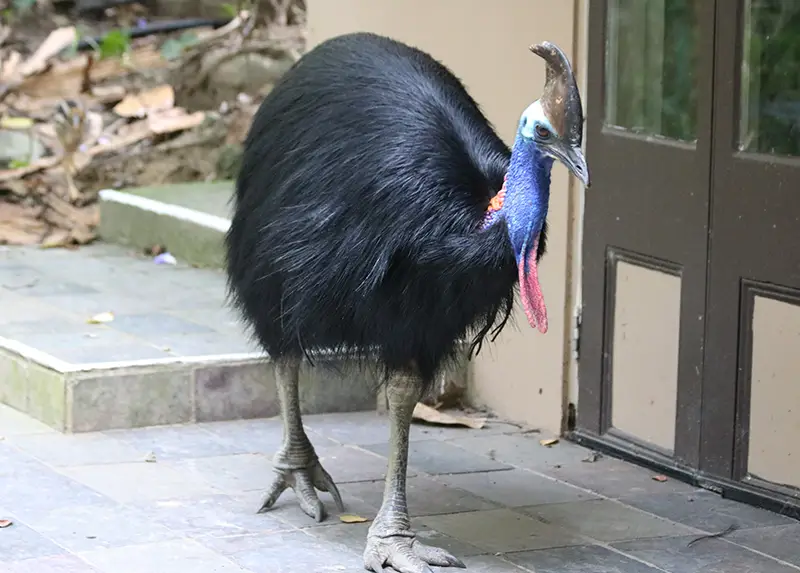
The southern cassowary is a large flightless black bird that can be found in Australia and New Guinea. It belongs to the ratite family, which consists of birds such as emus, ostriches, rheas and kiwis.
The southern cassowary has two wattles (fleshy protrusions) on its neck; this makes it stand out from other species of cassowaries since they usually only have one wattle.
This bird stands at an impressive height of up to 1.5m tall and weighs around 60kg.
They are omnivorous animals but favour fruits over anything else, although they also eat insects, small vertebrates like lizards or snakes and fungi too.
Southern Cassowaries play an important role in maintaining healthy ecosystems by dispersing seeds through their droppings – thus helping forests regenerate naturally.
Scientific classification:
| Kingdom | Animalia |
| Phylum | Chordata |
| Class | Aves |
| Infraclass | Palaeognathae |
| Order | Casuariiformes |
| Family | Casuariidae |
| Genus | Casuarius |
| Species | C. casuarius |
Also Featured In: Birds Typically Found in Australian Rainforest, Birds of Far North Queensland
15. Sulphur-Crested Cockatoo
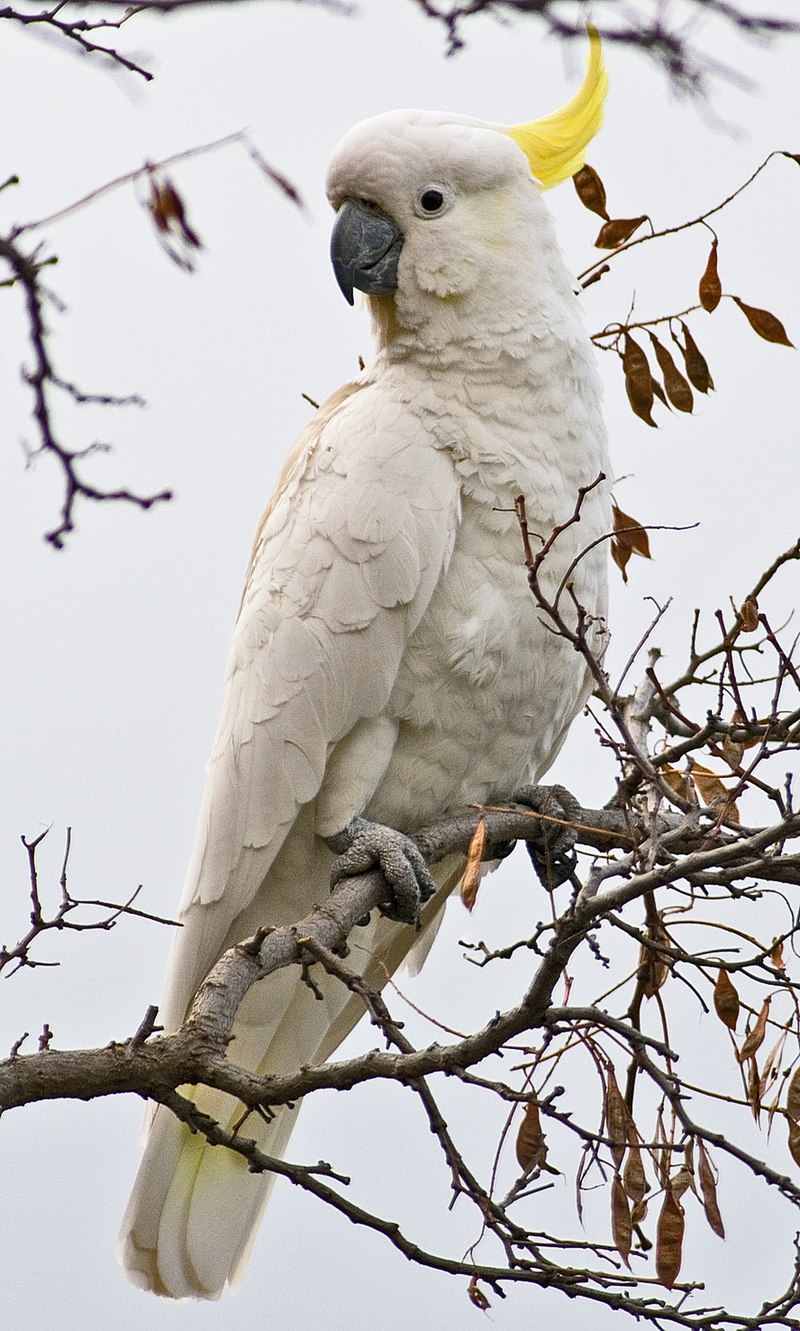
The Sulphur-crested Cockatoo (Cacatua galerita) is a white, relatively large cockatoo native to Australia, New Guinea and some of the islands in Indonesia.
They are highly intelligent birds with distinctive yellow crests on their heads.
These beautiful creatures can be found living in wooded habitats where they often form large flocks that sometimes cause problems as they become pests.
In aviculture, these parrots are very popular due to their intelligence and lively nature but it should be noted that they require an experienced birdkeeper or owner to properly take care of them since they can also be quite demanding pets at times.
All in all though, the Sulphur-crested Cockatoos remain one of the most beloved species among bird enthusiasts around the world.
Scientific classification:
| Kingdom | Animalia |
| Phylum | Chordata |
| Class | Aves |
| Order | Psittaciformes |
| Family | Cacatuidae |
| Genus | Cacatua |
| Subgenus | Cacatua |
| Species | C. galerita |
16. Superb Fairywren
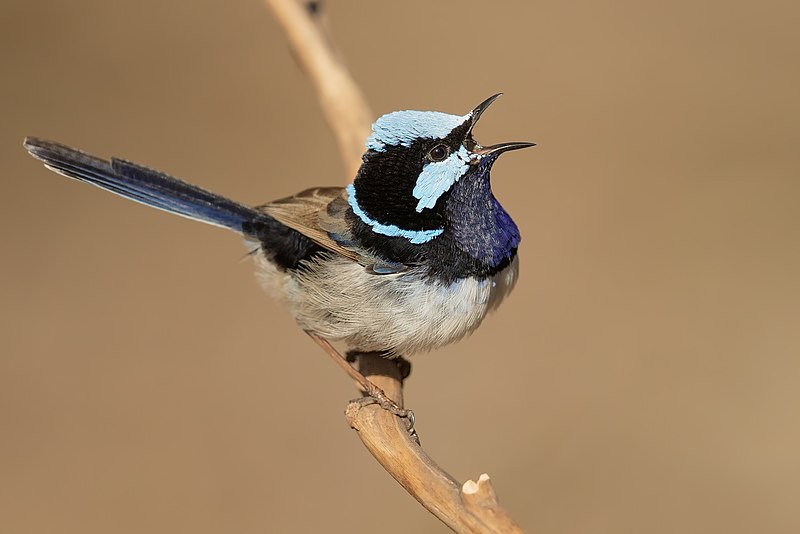
The Superb Fairywren is a beautiful and unique bird native to southeastern Australia.
The male in breeding plumage has an impressive bright blue forehead, ear coverts, mantle and tail with a black mask and either black or dark blue throat.
They are sedentary birds that form strong territorial bonds with their mates; the males staying close-by while the females build nests away from them.
These birds exhibit high sexual dimorphism; making it easy for us to distinguish between males and females of this species.
Their diet consists primarily of insects although they will also feed on other invertebrates as well as nectar, fruit and seeds when available.
This small passerine bird is sure to bring any garden alive with its vibrant colours.
Scientific classification:
| Kingdom | Animalia |
| Phylum | Chordata |
| Class | Aves |
| Order | Passeriformes |
| Family | Maluridae |
| Genus | Malurus |
| Species | M. cyaneus |
Also Featured In: Common Melbourne Birds, Birds of Tasmania
17. Gouldian Finch
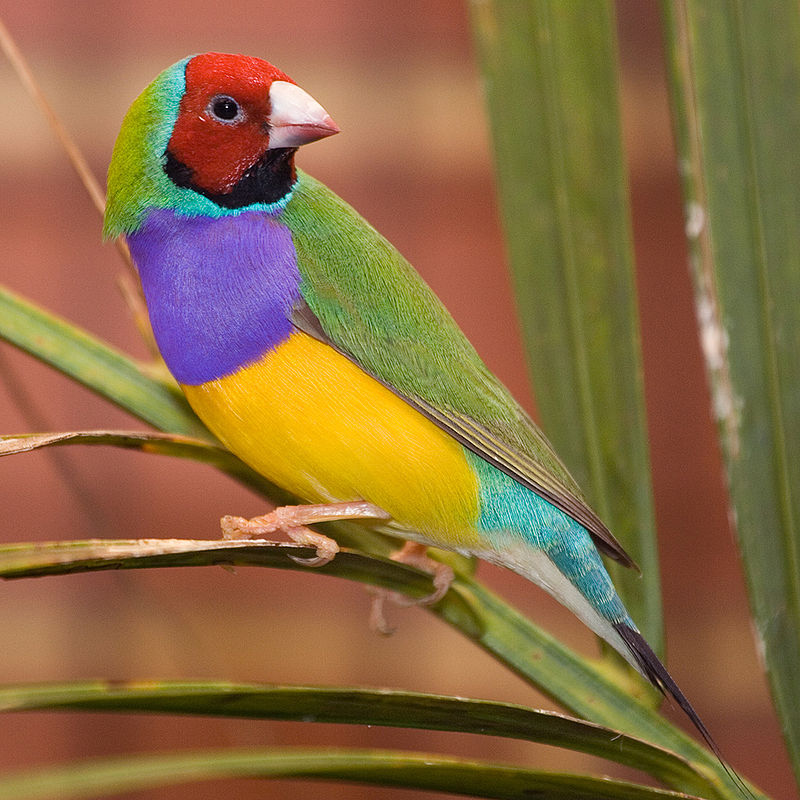
The Gouldian Finch, also known as the Lady Gouldian finch or Rainbow Finch, is a beautiful passerine bird native to Australia.
It was first described by British ornithological artist John Gould in 1844 and named after his late wife Elizabeth.
The specimens were sent to him by Benjamin Bynoe who collected them from Northern Australia.
These birds are loved for their vibrant colors which can range from yellow-green at its chest and head, purple on its wings and back with black stripes along the neckline down to some shades of blue around the tail feathers.
They feed mainly on grasses seeds but they may also eat insects when available. This species is critically endangered due mostly to habitat loss so special attention must be taken in order preserve this unique creature’s future existence.
Scientific classification:
| Kingdom | Animalia |
| Phylum | Chordata |
| Class | Aves |
| Order | Passeriformes |
| Family | Estrildidae |
| Genus | Chloebia Reichenbach, 1862 |
| Species | C. gouldiae |
18. Black Swan
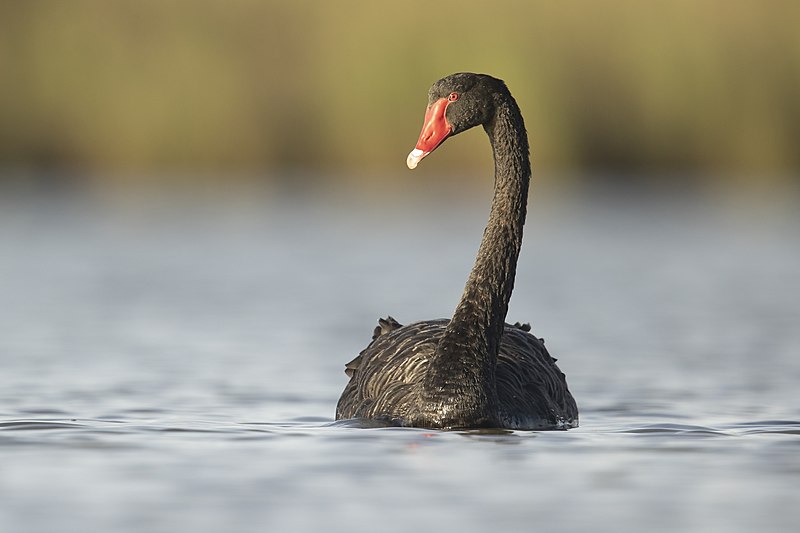
The Black Swan is a beautiful species of swan found in many parts of Australia. It has black plumage and a bright red bill, making it quite distinctive from other birds in the region.
These majestic birds are monogamous and both parents take turns incubating eggs as well as raising cygnets together.
They have an erratic migration pattern that depends on climatic conditions, although they usually move within their native range to find suitable habitats for breeding and feeding purposes.
The Black Swan’s graceful presence adds beauty to any water body they inhabit while also serving as important indicators of environmental health due to their sensitivity towards changes in their habitat quality.
Scientific classification:
| Kingdom | Animalia |
| Phylum | Chordata |
| Class | Aves |
| Order | Anseriformes |
| Family | Anatidae |
| Genus | Cygnus |
| Species | C. atratus |
Also Featured In: Most Common Western Australia Birds, Birds that You’ll find in Perth
19. Finches
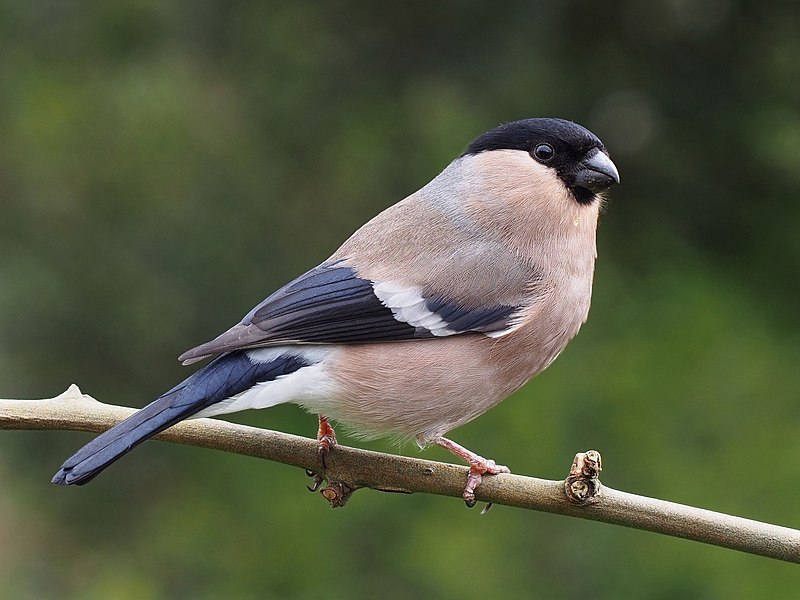
Finches are a diverse group of passerine birds found around the world, excluding Australia and polar regions. They vary in size from small to medium-sized, with stout conical bills adapted for eating seeds and nuts.
Many species have brightly coloured plumage; this helps them stand out against their natural habitats which can range from deserts to forests.
Finches occupy these areas all year round without migrating elsewhere – making them particularly well suited for local environments.
As part of the Fringillidae family they possess unique characteristics that make them popular amongst birdwatchers everywhere.
Scientific classification:
| Kingdom | Animalia |
| Phylum | Chordata |
| Class | Aves |
| Order | Passeriformes |
| Superfamily | Passeroidea |
| Family | Fringillidae Leach, 1820 |
20. Rainbow Bee-Eater
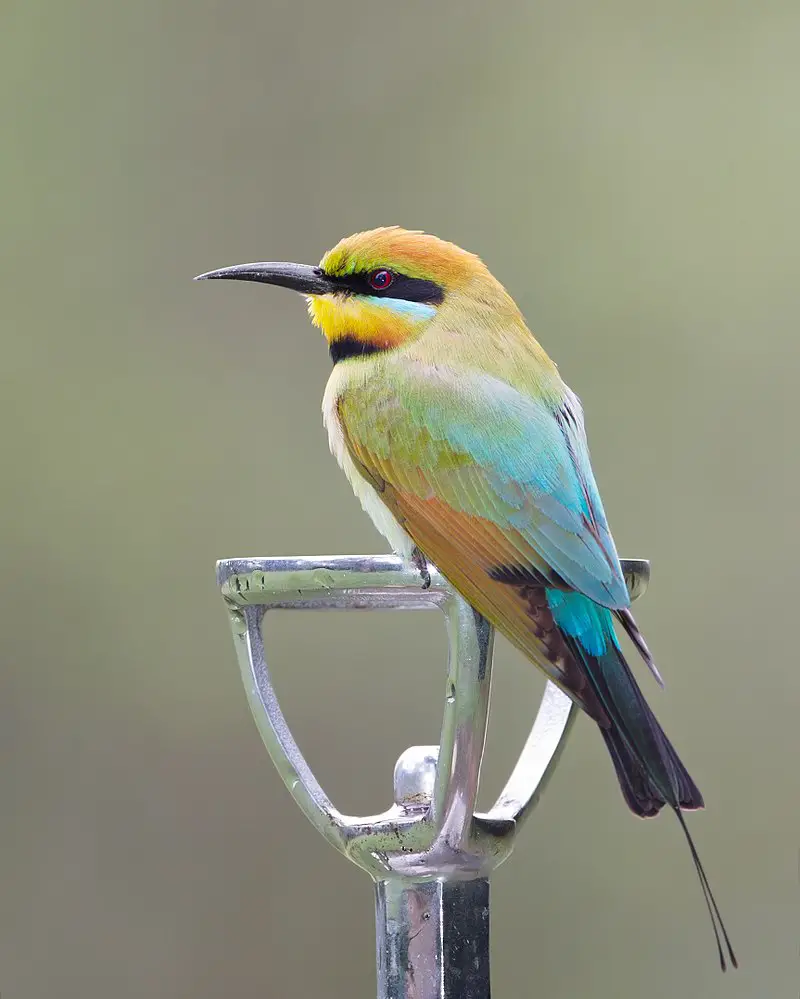
The Rainbow bee-eater (Merops ornatus) is a delightful near passerine bird belonging to the bee-eater family Meropidae.
It is found exclusively in Australia, making it one of only two species of its kind throughout the world; its closest relative being located in Southern and Eastern Africa – the olive bee-eater (Merops superciliosus).
Its stunning plumage features a unique palette of colours including shades pinkish reds, blues, greens and yellows which make for an impressive display when seen up close.
Due to their diet consisting mainly on bees and other insects they have adapted specialised beaks with serrated edges that allow them to easily capture their prey mid flight.
A truly remarkable sight indeed.
Scientific classification:
| Kingdom | Animalia |
| Phylum | Chordata |
| Class | Aves |
| Order | Coraciiformes |
| Family | Meropidae |
| Genus | Merops |
| Species | M. ornatus |
Also Featured In: Birds that Found in Kakadu National Park, Common Townsville Birds
21. Crested Pigeon
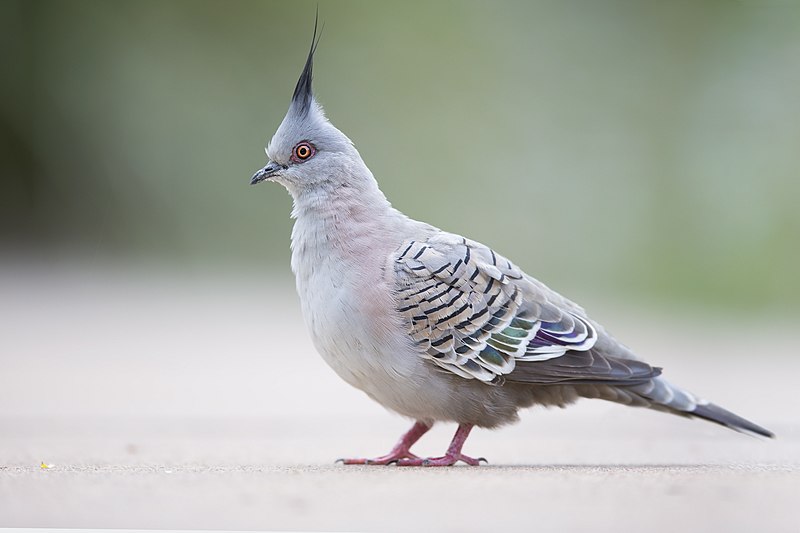
The Crested Pigeon is a medium-sized bird found widely across mainland Australia. It stands out from other pigeons due to its unique erect crest on the top of its head, which gives it an unmistakable look.
The body of this pigeon is slate grey in color with lighter gray undersides and chestnut colored wings that have white tips when they are open while flying.
Its striking black tipped yellow beak and pale blue eye ring add further interest to this beautiful species.
When alarmed, these birds will make loud clapping sounds by bringing their wings together above their backs as part of their defensive behavior.
Scientific classification:
| Kingdom | Animalia |
| Phylum | Chordata |
| Class | Aves |
| Order | Columbiformes |
| Family | Columbidae |
| Genus | Ocyphaps G.R. Gray, 1842 |
| Species | O. lophotes |
22. Wedge-Tailed Eagle
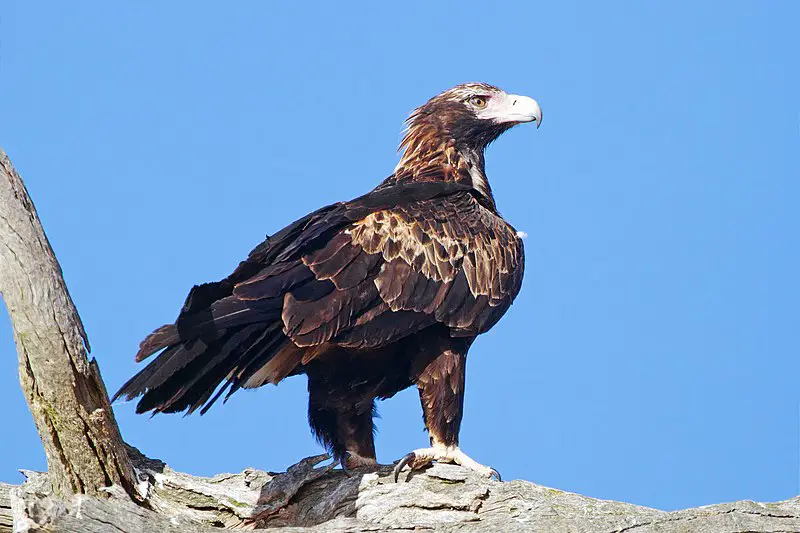
The majestic Wedge-tailed Eagle is a sight to behold in the skies above Australia, New Guinea and Tasmania.
With its long broad wings, fully feathered legs, distinctive wedge-shaped tail and powerful beak and feet it stands out from other birds of prey with ease.
This large raptor has an impressive wingspan ranging between 1.8m – 2.3m for males while females are slightly larger at up to 2.6m wide.
Its diet mainly consists of carrion but they have also been known to hunt for rabbits or small mammals such as rock wallabies when food is scarce due their sharp talons that can easily tear apart their prey’s flesh with one swift movement.
Despite being listed as near threatened these beautiful creatures still remain fairly common throughout its range making them a true delight to see soaring through our Aussie skies.
Scientific classification:
| Kingdom | Animalia |
| Phylum | Chordata |
| Class | Aves |
| Order | Accipitriformes |
| Family | Accipitridae |
| Genus | Aquila |
| Species | A. audax |
23. Little Penguin
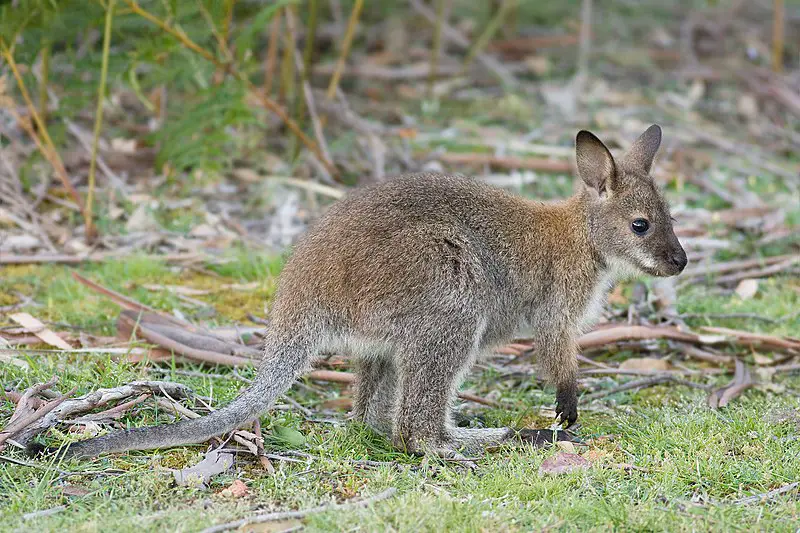
The Little Penguin, also known as the Fairy Penguin, is a species of penguin native to Australia and New Zealand. These diminutive birds are only about 33 cm (13 inches) tall when fully grown and weigh just 1 kg (2 lbs).
They have slate-blue upperparts with white underparts and black heads with white facial markings. While they spend most of their time in water hunting for food such as fish and squid, they come ashore at night to rest on land or lay eggs during breeding season.
In some areas, these charming little creatures can be observed waddling up beaches after dark in large groups. As one of the smallest species of penguins living today, it’s no wonder why many people find them so endearing – even if you don’t live near their natural habitats down south.
24. Cockatiel
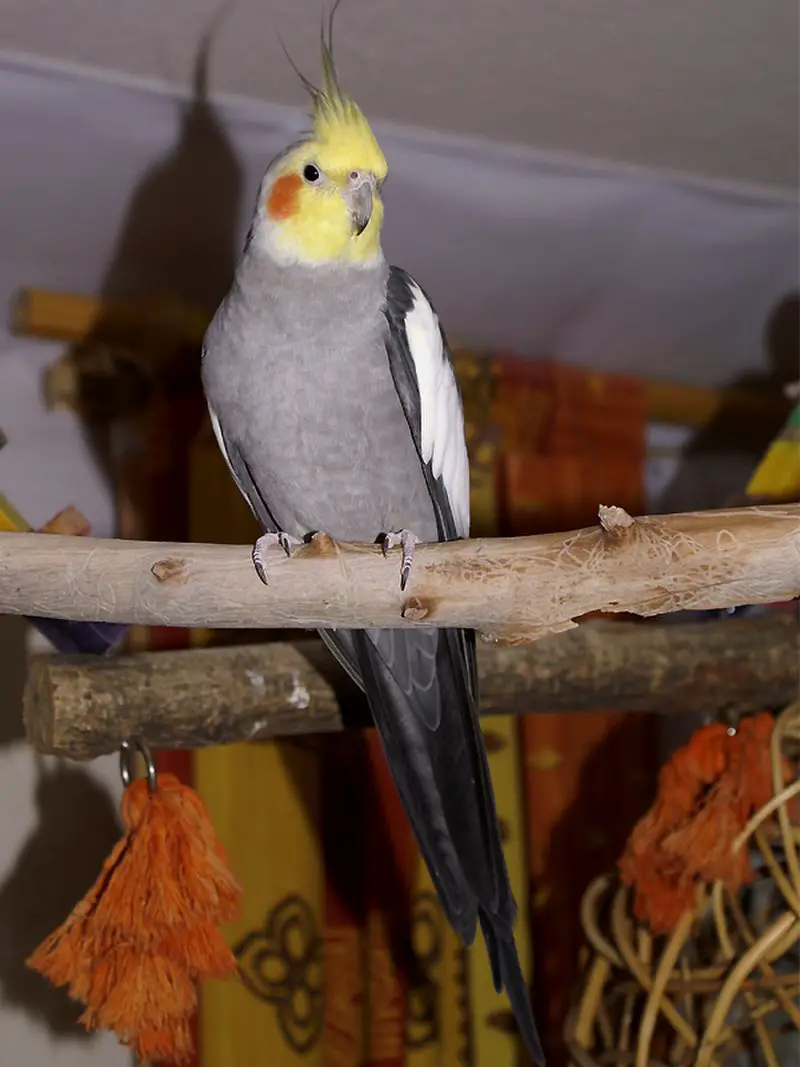
Cockatiels are a medium-sized parrot that is native to Australia and make popular pets around the world.
They have an endearing personality, making them ideal companions for bird owners of all ages.
Cockatiels can be taught tricks, they love interacting with people, and many enjoy being handled as well.
These birds also have beautiful plumage in shades of yellow, white and grey which makes them even more desirable as pet birds.
Their diet should include fresh fruits & veggies along with high-quality seeds or pellets specially formulated for cockatiel’s needs.
With proper care these clever little parrots can live up to 15 years so it’s important to provide them with lots of love and attention.
Scientific classification:
| Kingdom | Animalia |
| Phylum | Chordata |
| Class | Aves |
| Order | Psittaciformes |
| Family | Cacatuidae |
| Subfamily | Nymphicinae |
| Genus | Nymphicus Wagler, 1832 |
| Species | N. hollandicus |
25. Pheasant Coucal
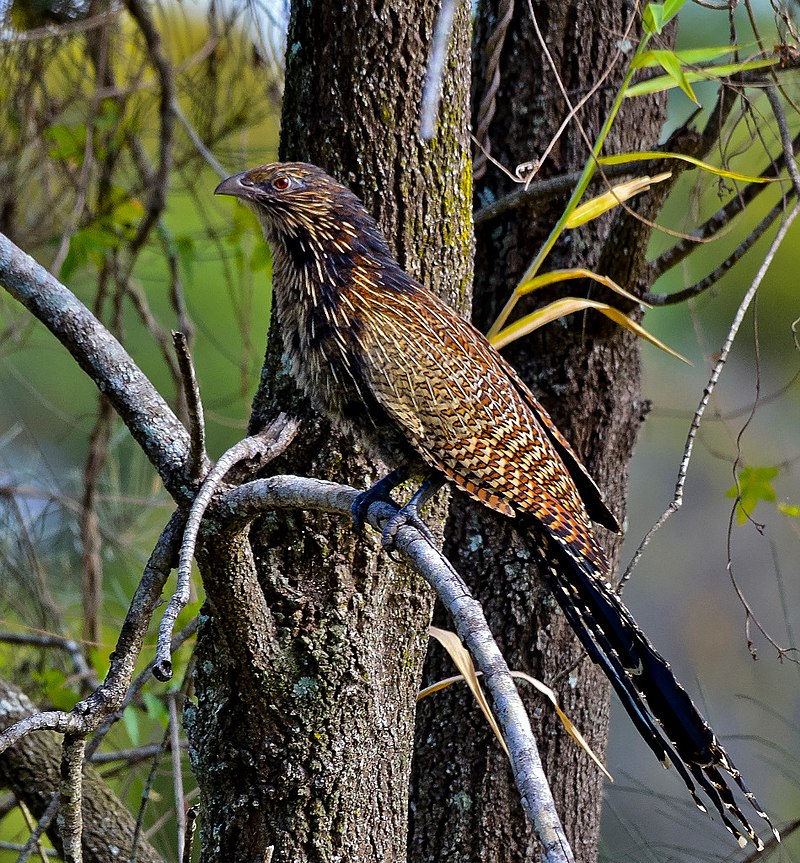
The Pheasant Coucal is a species of cuckoo native to Australia, Timor and New Guinea.
It can be found in subtropical or tropical moist lowland forests as well as mangrove forests but has also adapted well to agricultural areas such as cane fields in Northern Australia.
This makes it an unusual bird among the Australian cuckoos since unlike most other birds from this family, it doesn’t rely on its hosts for incubation and raising offsprings – instead, it does all that by itself.
The female typically lays three eggs which are oval-shaped with light blue colouring that fades over time.
Pheasant coucals have dark brown feathers with some lighter markings around their necks and wings making them look quite unique compared to other birds within the same family.
Scientific classification:
| Kingdom | Animalia |
| Phylum | Chordata |
| Class | Aves |
| Order | Cuculiformes |
| Family | Cuculidae |
| Genus | Centropus |
| Species | C. phasianinus |
Also Featured In: Birds that Live in Gold Coasts, Native Birds Of Mackay
26. Malleefowl
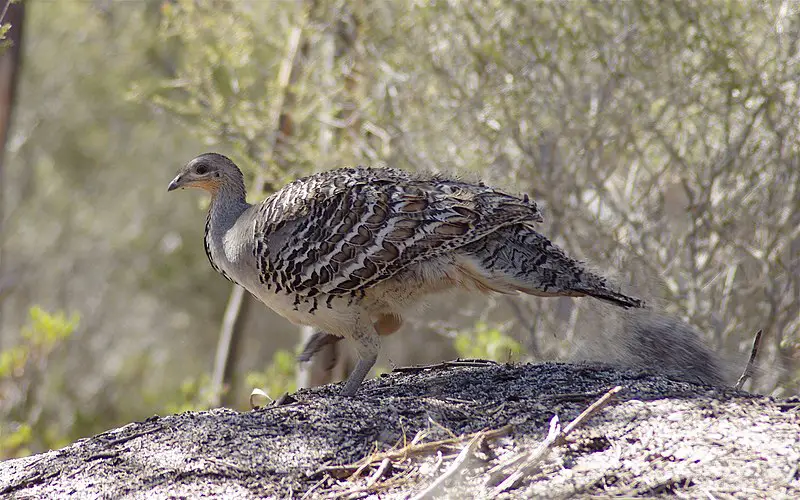
Malleefowl are native to Australia and resemble a domestic chicken in size. They prefer open woodlands or grassy plains with plenty of shrubs for cover.
These birds live on the ground and almost never fly, but their strong legs allow them to run quickly over short distances.
The males build large nesting mounds every year where they lay eggs which hatch without parental care from either parent.
Though only one species of malleefowl still exists today, its close relative was once much larger before becoming extinct.
This unique bird is an important part of Australia’s wildlife heritage that should be protected and appreciated by all Australians.
Scientific classification:
| Kingdom | Animalia |
| Phylum | Chordata |
| Class | Aves |
| Order | Galliformes |
| Family | Megapodiidae |
| Genus | Leipoa Gould, 1840 |
| Species | L. ocellata |
27. Australian Pelican
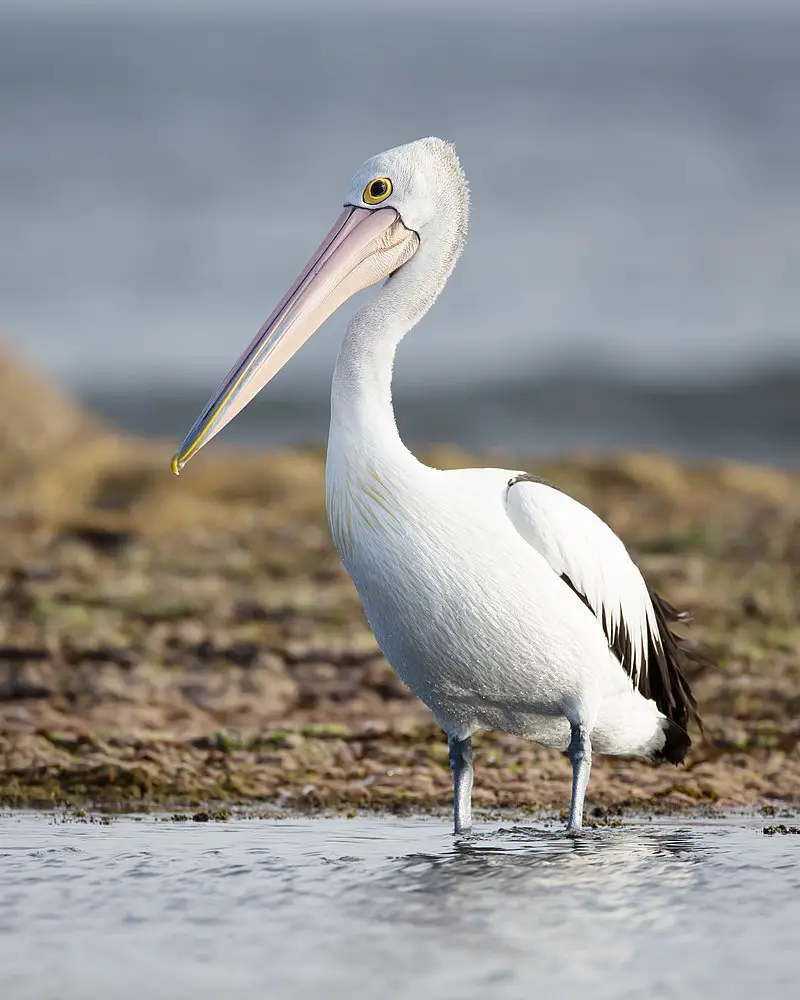
The Australian pelican is a majestic large waterbird with predominantly white plumage and black wings.
It has the longest bill of any living bird, which it uses to fish for its main source of food in both inland and coastal waters of Australia, New Guinea, Fiji, parts of Indonesia and as a vagrant in New Zealand.
They usually feed together by forming lines or circles around their prey before dipping down into the water at once.
In addition to fishing they also scavenge on other sources such as eggs from nesting seabirds or carrion.
Their unique appearance makes them an iconic species that can be easily recognised across many areas throughout Australasia making them popular amongst tourists who come to see them up close.
Scientific classification:
| Kingdom | Animalia |
| Phylum | Chordata |
| Class | Aves |
| Order | Pelecaniformes |
| Family | Pelecanidae |
| Genus | Pelecanus |
| Species | P. conspicillatus |
Also Featured In: Birds of New Caledonia, Birds that Live in Kangaroo Island
28. Noisy Miner
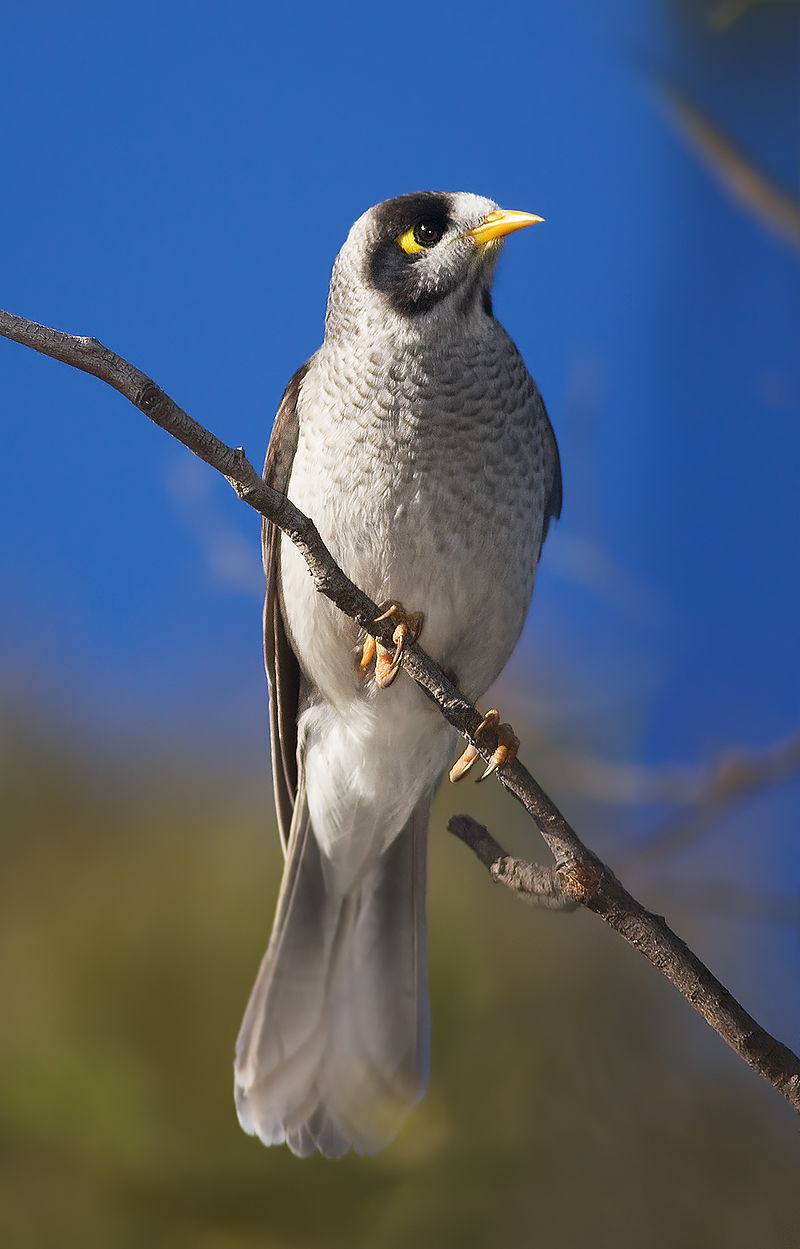
The Noisy Miner is a beautiful bird native to eastern and southeastern Australia. It has a grey body, black head, orange-yellow beak and feet, with an eye patch that ranges from yellow to more intense in Tasmanian birds.
The tail feathers are distinguished by white tips which provide it with its signature look. These miners have the ability to produce loud calls when communicating or defending their territory – hence their name.
They mainly feed on fruit but also insects, nectar and small lizards found around gardens.
As they are quite common in urban areas of Australia, these birds make for some delightful avian visitors.
Scientific classification:
| Kingdom | Animalia |
| Phylum | Chordata |
| Class | Aves |
| Order | Passeriformes |
| Family | Meliphagidae |
| Genus | Manorina |
| Species | M. melanocephala |
29. Rosellas
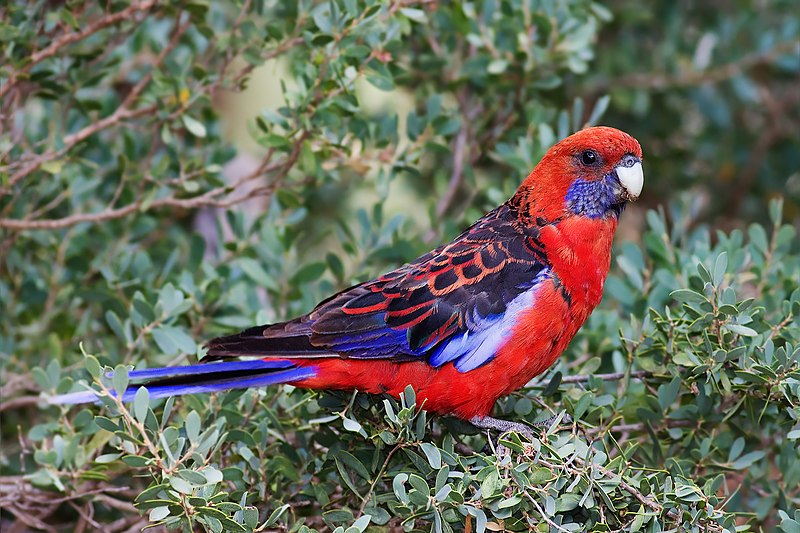
Rosellas are beautiful, colorful parrots native to Australia that belong to the genus Platycercus. They have broad tails and a diet consisting mainly of seeds and fruit.
There are six species with 19 subspecies in total. Their bright plumage is one of their most distinctive features, making them popular among bird enthusiasts around the world.
Rosellas can be seen perched on tree branches or flying freely through woodlands across much of Australia’s eastern coast as well as Tasmania’s south-western regions.
Many people enjoy having rosellas as pets due to their attractive colors and lively personalities.
Scientific classification:
| Kingdom | Animalia |
| Phylum | Chordata |
| Class | Aves |
| Order | Psittaciformes |
| Family | Psittaculidae |
| Tribe | Platycercini |
| Genus | Platycercus Vigors, 1825 |
Also Featured In: Red Birds that Found in the United States America,
30. New Holland Honeyeater
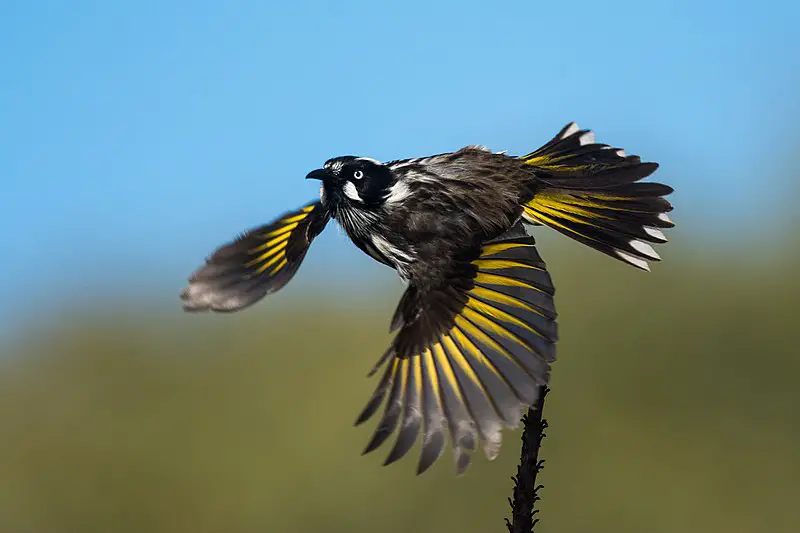
The New Holland honeyeater is a distinctive bird found in southern Australia. It has five subspecies and measures 18 cm long, with mainly black feathers contrasting against its white eyes.
This species was among the first to be scientifically described in Australia, known as Certhia novaehollandiae at that time.
These birds are very active and can often be seen searching for food or bathing on hot days near water sources such as streams or lakes.
They have an impressive range of vocalizations which they use to communicate with each other when looking for mates or defending their territories from intruders.
The New Holland Honeyeaters feed primarily on nectar but also consume insects, lizards, spiders and seeds when available throughout the year – making them essential pollinators within Australian ecosystems.
Scientific classification:
| Kingdom | Animalia |
| Phylum | Chordata |
| Class | Aves |
| Order | Passeriformes |
| Family | Meliphagidae |
| Genus | Phylidonyris |
| Species | P. novaehollandiae |
31. Night Parrot
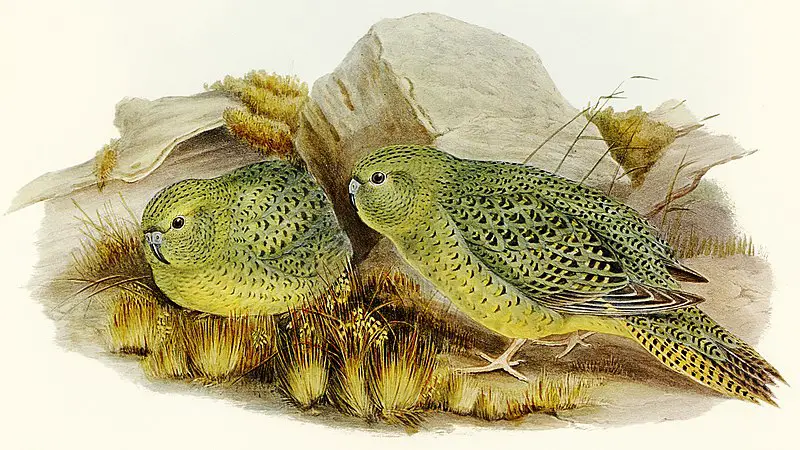
The Night Parrot is one of the most mysterious birds on Earth due to its extreme elusiveness. It is a small parrot endemic to Australia and can also be known as porcupine parrot, nocturnal ground parakeet, midnight cockatoo, solitaire, or spinifex parrot.
For 67 years there were no confirmed sightings of this bird until 1979 when it was rediscovered in western Queensland.
Its secretive behavior makes it difficult for humans to observe these creatures properly and many attempts have been made by researchers over the decades ever since then in order try get more information about them but with limited success so far.
The future looks uncertain for these special creatures however hopefully through continued research we will find out much more about them soon.
Scientific classification:
| Kingdom | Animalia |
| Phylum | Chordata |
| Class | Aves |
| Order | Psittaciformes |
| Family | Psittaculidae |
| Genus | Pezoporus |
| Species | P. occidentalis |
Also Featured In: Birds You’ll Find in Night,
32. Frogmouth
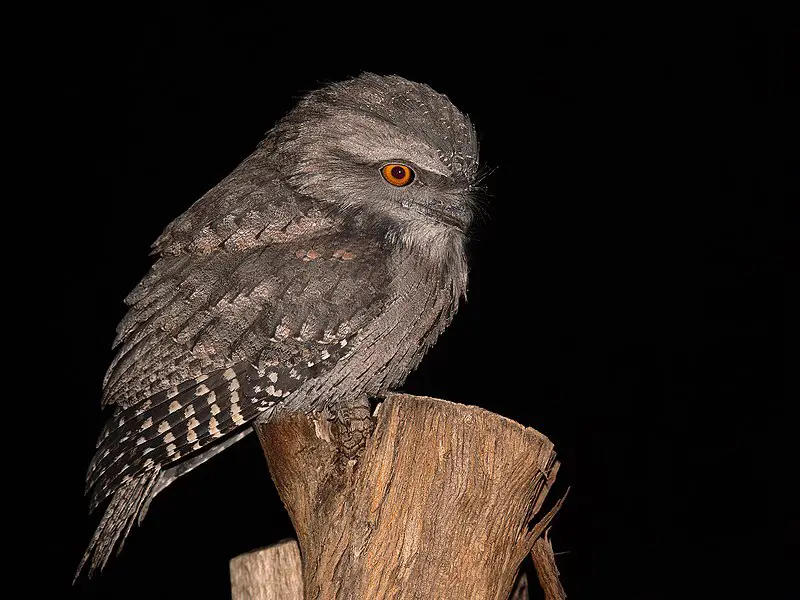
The Frogmouth is a nocturnal bird that belongs to the same family as owlet-nightjars, swifts and hummingbirds.
They have large flattened hooked bills with huge frog-like gape which helps them capture insects during night time.
Three species of Podargus are found in Australia and New Guinea only – they have massive eyes that allow for excellent night vision.
Their bodies are generally grey or brownish in colour with cryptic markings for camouflage when roosting during day light hours.
Generally known as quiet birds, their loud wailing call can be heard at dusk or dawn near river banks or wetlands where they live alone or form pairs throughout breeding season.
The diet of these fascinating creatures consists mainly of flying insects such as moths, beetles & cicadas etc., but on occasion will consume small vertebrates like lizards and frogs too.
Scientific classification:
| Kingdom | Animalia |
| Phylum | Chordata |
| Class | Aves |
| Clade | Strisores |
| Order | Podargiformes Matthews, 1918 |
| Family | Podargidae Gray, 1847 |
33. Lyrebird
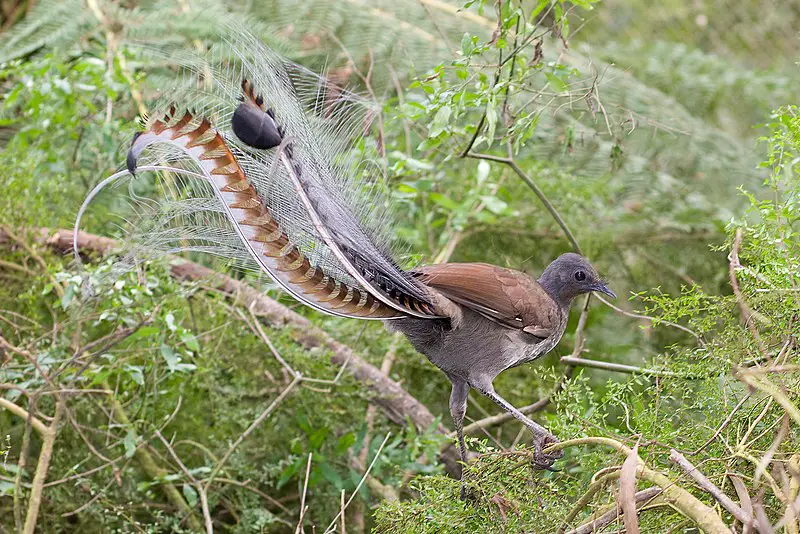
The Lyrebird is an amazing species of ground-dwelling bird native to Australia. It has the ability to mimic different sounds from its environment, both natural and artificial.
The male’s beautiful tail feathers are especially impressive when fanned out during courtship displays. They have unique plumes of neutral coloured feathers that set them apart from other birds in the area.
These remarkable animals can be heard singing a range of songs with their mimicked calls being incredibly accurate. Alongside this they also perform intricate dances which further add to their charm and beauty as they try to attract mates or ward off predators.
Lyrebirds truly are some of nature’s most captivating creatures.
Scientific classification:
| Kingdom | Animalia |
| Phylum | Chordata |
| Class | Aves |
| Order | Passeriformes |
| Family | Menuridae Lesson, 1828 |
| Genus | Menura Latham, 1801 |
34. Spotted Dove
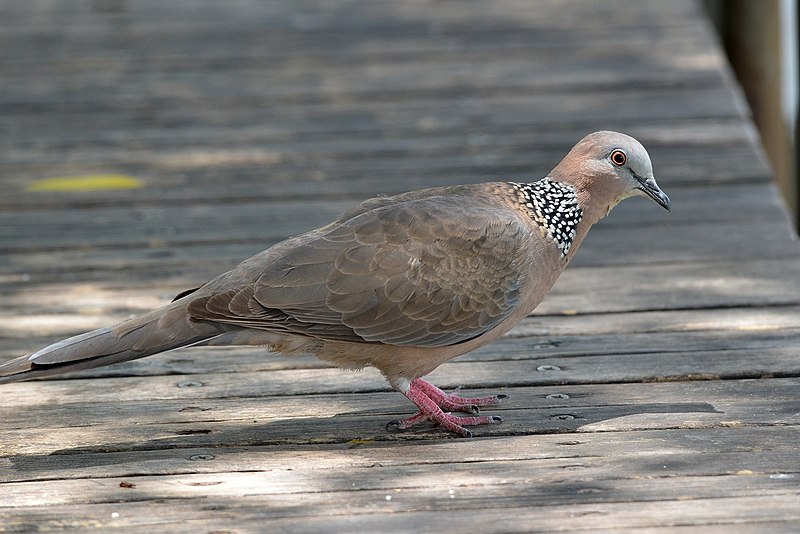
The Spotted Dove is a common species of pigeon found in the Indian subcontinent and Southeast Asia. It has an elegant, slender body with small head, long tail feathers and spotted wings.
Its coloring ranges from grey to brownish-grey on its upperparts with white underparts that are speckled black or dark grey. The male generally has more prominent spots than the female.
They feed mainly on seeds but will also consume insects when available during breeding season as well as berries, grains and fruits throughout their range.
These birds typically live in pairs or small groups near water sources such as ponds, rivers or streams where they can find food easily while staying safe from predators like cats and hawks.
Scientific classification:
| Kingdom | Animalia |
| Phylum | Chordata |
| Class | Aves |
| Order | Columbiformes |
| Family | Columbidae |
| Genus | Spilopelia |
| Species | S. chinensis |
35. Orange-Footed Scrubfowl

The Orange-footed Scrubfowl is a small Megapode of the family Megapodiidae found in several islands from Lesser Sunda Islands to southern New Guinea and northern Australia.
It has a dark brown coloration with bright orange legs and feet that stand out against its body, making it quite an eye-catching species.
The bird’s size is roughly equal to that of a domestic chicken.
This species feeds mainly on insects, fruits, seeds and roots but will also scavenge for carrion or feed on worms when available.
They are typically solitary birds except during breeding season when they tend to form colonies near their nesting sites usually along beaches or sand dunes where they can use the heat generated by the sun reflecting off the sand in order to incubate their eggs without having build nests themselves.
Overall this unique bird stands apart from other members of its family due to its striking plumage as well as being one of few ground dwelling megapodes instead of tree dwellers like most others within this group which makes them relatively easy to spot among greenery if you know what you’re looking for.
Scientific classification:
| Kingdom | Animalia |
| Phylum | Chordata |
| Class | Aves |
| Order | Galliformes |
| Family | Megapodiidae |
| Genus | Megapodius |
| Species | M. reinwardt |
36. Bush Stone-Curlew
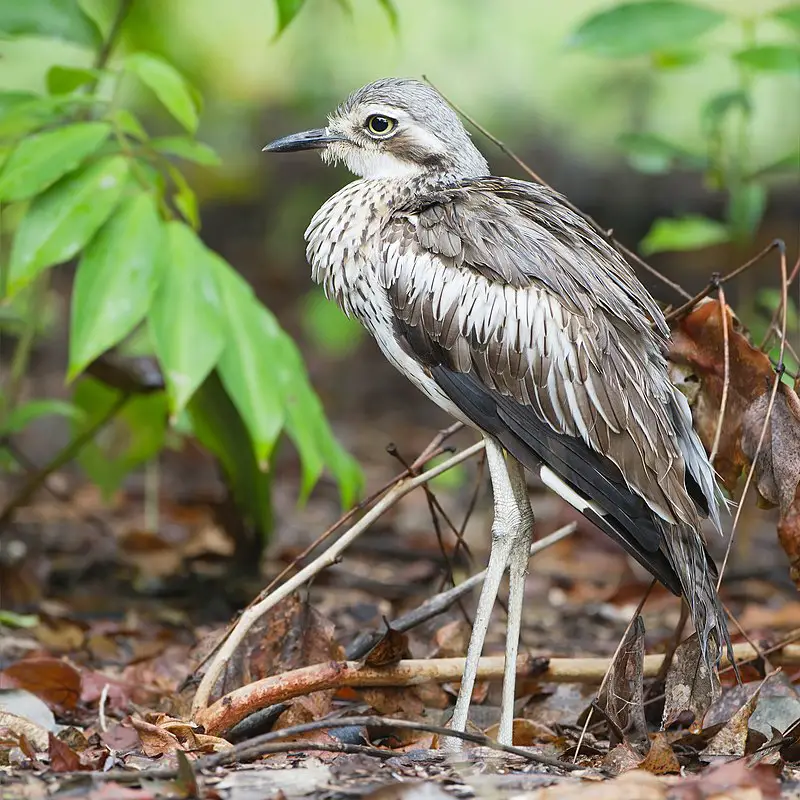
The Bush Stone-Curlew, also known as the Iben Bird, is an endemic species of Australia found in open plains and woodlands. It has grey-brown coloration with dark streaks and large eyes, making it easy to identify.
During night time this bird looks for invertebrates such as insects by slowly stalking its prey. Its long legs allow it to easily traverse across vast landscapes while hunting for food.
The Bush Stone-Curlew plays a vital role in maintaining balance within the ecosystem through controlling insect population growth which can be damaging if not monitored carefully.
Unfortunately due to human interference this species has become endangered so all efforts should be made towards conserving them before they are lost forever from our planet’s biodiversity.
Scientific classification:
| Kingdom | Animalia |
| Phylum | Chordata |
| Class | Aves |
| Order | Charadriiformes |
| Family | Burhinidae |
| Genus | Burhinus |
| Species | B. grallarius |
37. Gruiformes
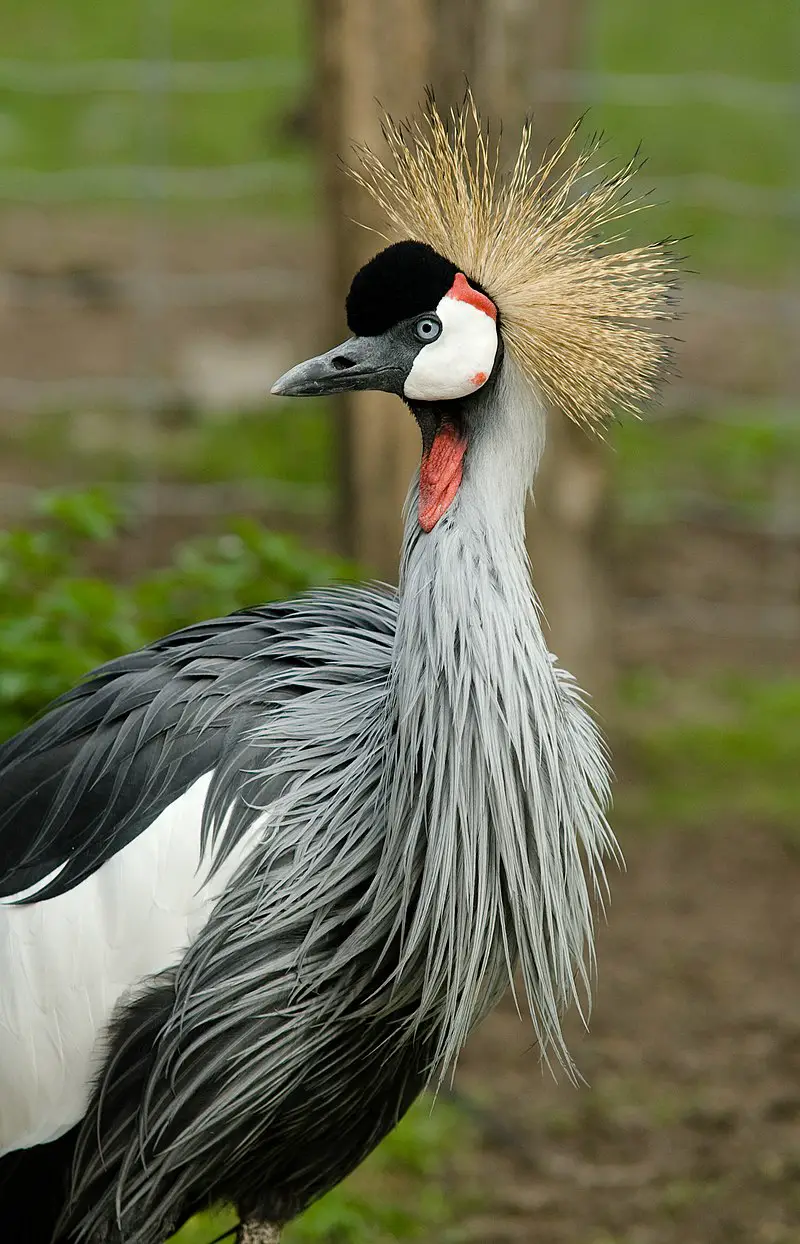
The Gruiformes is an order of birds which contains a large variety of families, both living and extinct. They are found all over the world in many different habitats, including wetlands and grasslands.
The name comes from Latin for “crane-like” due to their similar appearance to cranes. Many members of this group have long legs adapted for wading or running on land depending on species.
They also typically have long beaks used for hunting prey such as insects and small animals like fish, frogs and lizards.
Other traits commonly shared by these birds include strong wings with broad flight feathers that help them soar through the air when migrating or searching food sources during winter months.
In addition to these physical characteristics, some Gruiformes also possess vocalizations unique among other bird orders – making them easily recognizable even at great distances.
Scientific classification:
| Kingdom | Animalia |
| Phylum | Chordata |
| Class | Aves |
| Clade | Gruimorphae |
| Order | Gruiformes Bonaparte, 1854 |
38. Major Mitchell’s Cockatoo
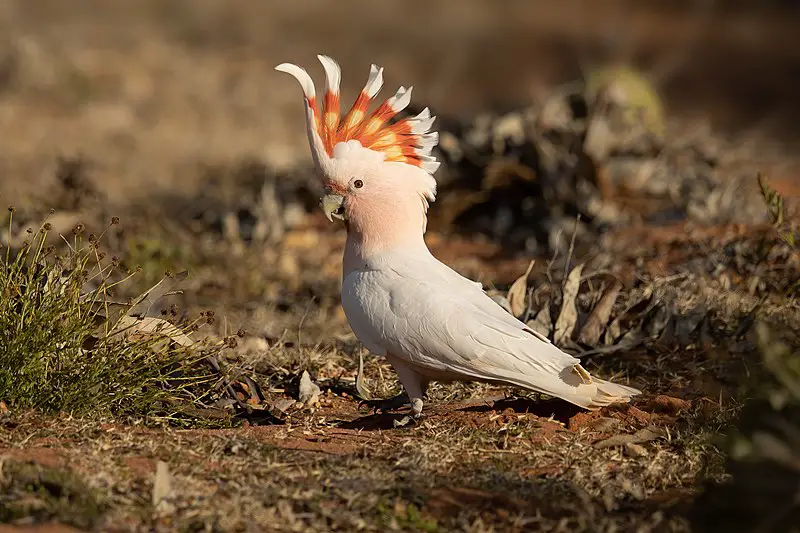
The Major Mitchell’s cockatoo is a medium-sized bird native to arid and semi-arid regions of Australia. It has been seen in other climates, such as South-East Queensland’s subtropical region.
The species was first described by Irish naturalist Nicholas Aylward Vigors in 1831 under the name Plyctolophus leadbeateri.
This pink cockatoo has distinctive grey downy feathers on its back and wings which contrast with its snowy white head, chest and tail feathers.
Its red crest stands out against the otherwise monochrome body when it spreads open during displays of excitement or aggression.
Despite being quite rare, these birds are hardy survivors that can live up to 80 years if given proper care and nutrition.
Scientific classification:
| Kingdom | Animalia |
| Phylum | Chordata |
| Class | Aves |
| Order | Psittaciformes |
| Family | Cacatuidae |
| Genus | Lophochroa Bonaparte, 1857 |
| Species | L. leadbeateri |
39. Columbiformes

The Little Penguin, also known as the Fairy Penguin, is a species of penguin native to Australia and New Zealand. These diminutive birds are only about 33 cm (13 inches) tall when fully grown and weigh just 1 kg (2 lbs).
They have slate-blue upperparts with white underparts and black heads with white facial markings. While they spend most of their time in water hunting for food such as fish and squid, they come ashore at night to rest on land or lay eggs during breeding season.
In some areas, these charming little creatures can be observed waddling up beaches after dark in large groups. As one of the smallest species of penguins living today, it’s no wonder why many people find them so endearing – even if you don’t live near their natural habitats down south.
40. Pacific Gull
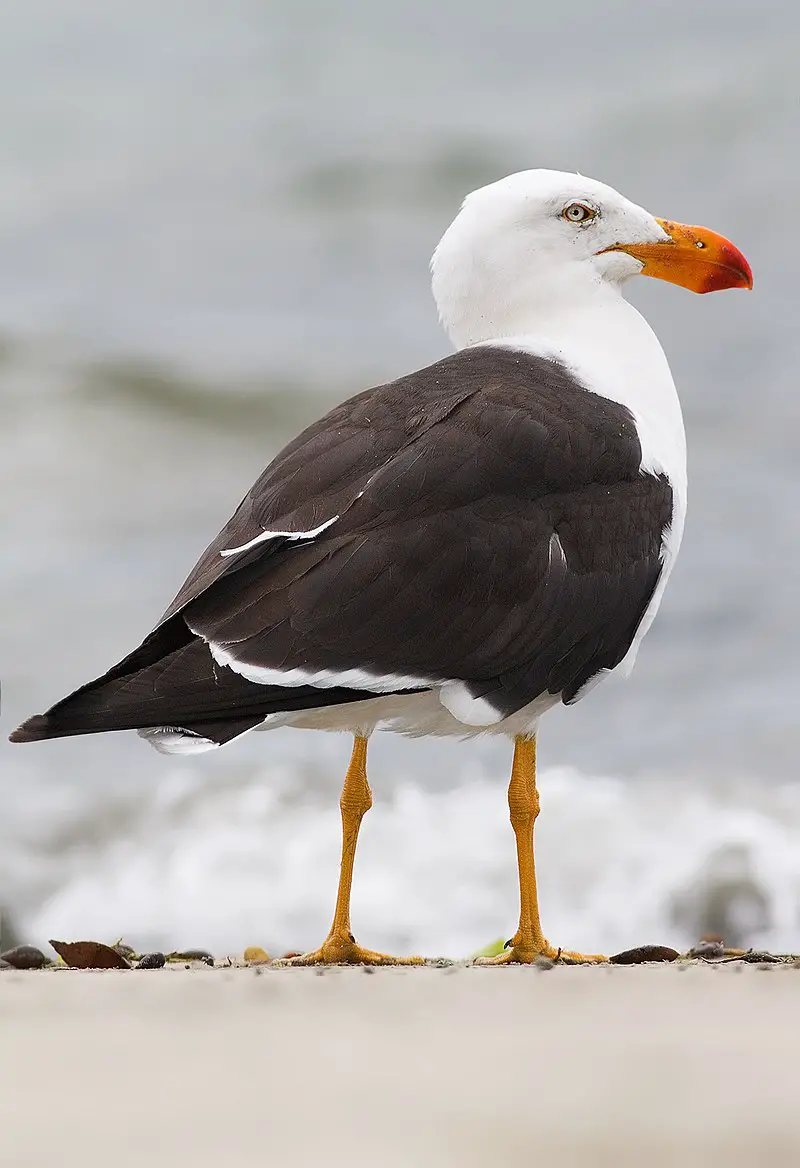
The Pacific gull is a majestic species of bird, native to the coasts of Australia. It stands out among other birds due to its size; it’s much larger than the ubiquitous silver gull and can reach up to 70cm when fully grown.
Unfortunately, this magnificent species has become scarce in some areas of south-east Australia as a result of competition from kelp gulls that were introduced during the 1940s.
Despite their decline in certain areas, these amazing creatures are still moderately common between Carnarvon and Sydney.
With white plumage on top, grey wings and black legs they make for quite an impressive sight.
Scientific classification:
| Kingdom | Animalia |
| Phylum | Chordata |
| Class | Aves |
| Order | Charadriiformes |
| Family | Laridae |
| Genus | Larus |
| Species | L. pacificus |
41. Splendid Fairywren
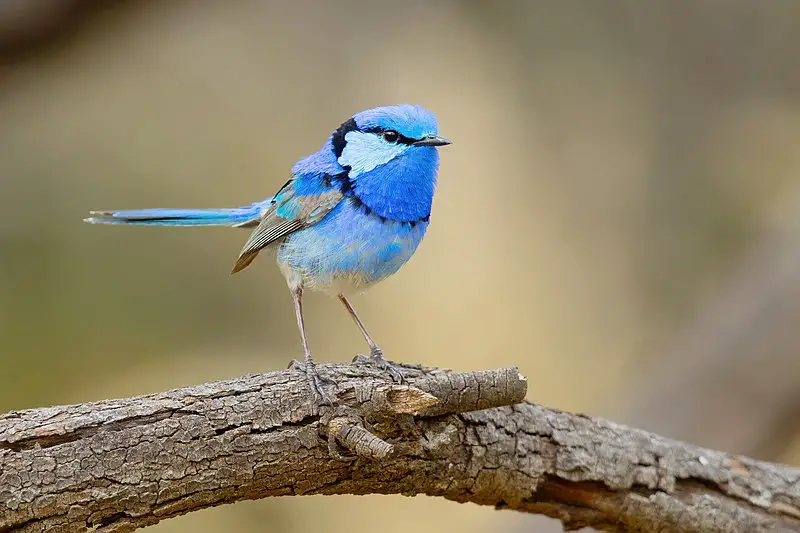
The Splendid Fairywren is a beautiful little passerine bird belonging to the Maluridae family. It can be found across much of Australia, from central-western New South Wales and southwestern Queensland over to coastal Western Australia.
This small wren resides in different pre-forested areas including woodlands, heaths and shrubbery as well as urban gardens; they often form lifetime pair bonds with each other during breeding season.
The male has an impressive display plumage that consists of bright blue on its wings, tail and rump while the female’s feathers are more brownish gray in color.
They feed mainly on insects but also eat nectar for sustenance when available. The Splendid Fairywren is quite common throughout its range thanks to their adaptability which allows them to thrive even near humans.
Scientific classification:
| Kingdom | Animalia |
| Phylum | Chordata |
| Class | Aves |
| Order | Passeriformes |
| Family | Maluridae |
| Genus | Malurus |
| Species | M. splendens |
42. Eurasian Coot
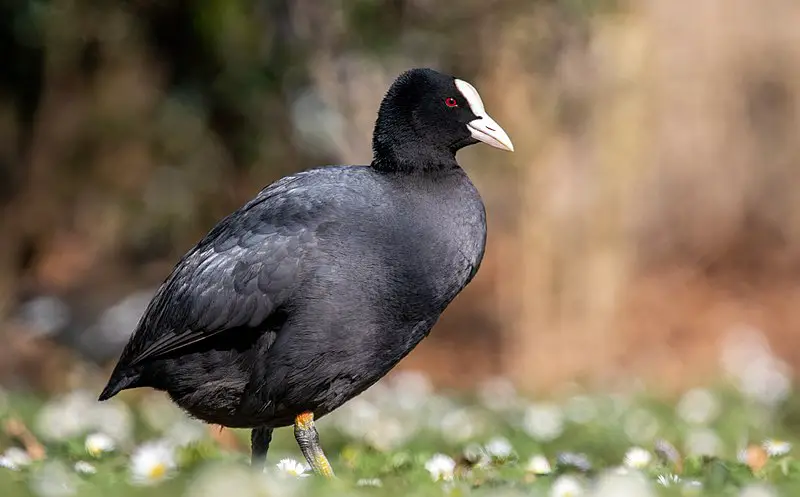
The Eurasian Coot is a water bird belonging to the Rallidae family. It has an overall slaty-black body with a glossy black head and white bill, along with a white frontal shield.
Both male and female coots look similar in appearance. This species can be found across Europe, Asia, Australia, New Zealand and parts of North Africa – making it quite widespread.
In terms of behavior they usually feed on aquatic plants as well as insects while swimming or walking on land near bodies of water such as ponds or lakes.
They are also known for their aggressive nature when defending nesting sites from other birds during breeding season.
Scientific classification:
| Kingdom | Animalia |
| Phylum | Chordata |
| Class | Aves |
| Order | Gruiformes |
| Family | Rallidae |
| Genus | Fulica |
| Species | F. atra |
43. Rose-Crowned Fruit Dove
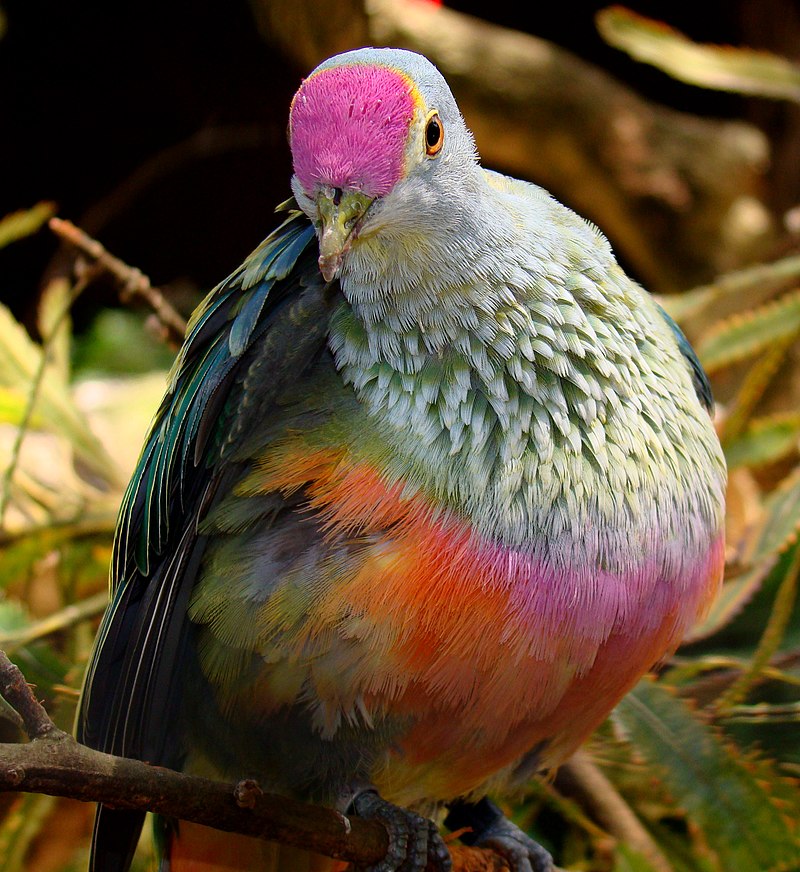
The Rose-crowned Fruit Dove is a beautiful and vibrant bird found mainly in the forests of Australia, New Guinea and some parts of Indonesia.
It has an unmistakable appearance due to its grey head and breast, orange belly, whitish throat and yellow-orange iris.
The crown on its head is pinkish-red with a yellow border which sets it apart from other fruit doves. This species can grow up to 22 cm long and have greyish green bills as well as feet.
In Indonesian subspecies however have white crowns instead of red ones.
They are generally found in small groups feeding on fruits or berries near trees or shrubs but they may also be seen alone occasionally when searching for food during the day time.
Scientific classification:
| Kingdom | Animalia |
| Phylum | Chordata |
| Class | Aves |
| Order | Columbiformes |
| Family | Columbidae |
| Genus | Ptilinopus |
| Species | P. regina |
44. Kingfisher
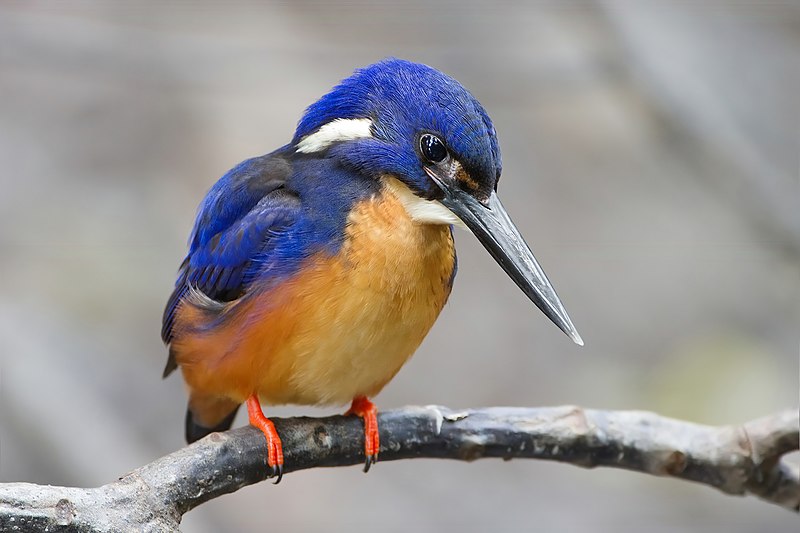
Kingfishers are a vibrant and unique family of birds, with most species found in tropical regions across Africa, Asia, Oceania and Europe.
Their bright colors make them easily identifiable among the foliage of deep forests near calm ponds or rivers.
They come in three subfamilies: tree kingfishers (Halcyoninae), water kingfishers (Cerylinae) and river kingfishers (Alcedinidae).
Kingfisher birds have short legs used for perching along branches overhanging streams or lakes; they also possess strong beaks perfect for catching fish.
These little hunters will remain motionless as if suspended from thin air until an unsuspecting prey comes within reach.
Then they swoop down quickly to grab their meal. With 116 different species making up this incredible family, there’s something special about every single one.
Scientific classification:
| Kingdom | Animalia |
| Phylum | Chordata |
| Class | Aves |
| Order | Coraciiformes |
| Suborder | Alcedines |
| Family | Alcedinidae Rafinesque, 1815 |
45. Carnaby’s Black Cockatoo
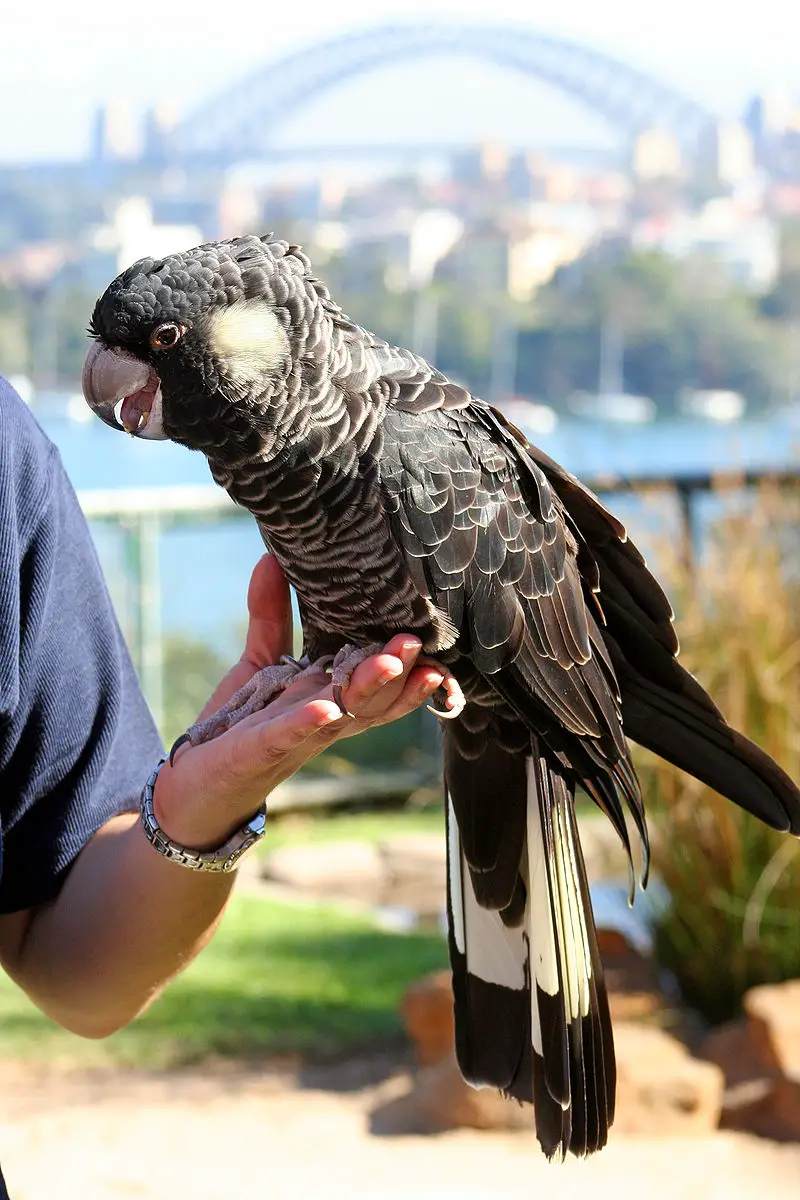
Carnaby’s black cockatoo is a large, stunning bird native to southwest Australia. Measuring 53-58 cm in length and with an unmistakable short crest on its head, the striking plumage of this species consists mostly of greyish black feathers.
It also has white cheek patches and a distinctive white tail band that makes it stand out from other members of its family.
Carnaby’s black cockatoo loves eating seeds, nuts, insects and flowers; however their numbers have been decreasing due to habitat loss.
Conservation efforts are necessary if we want these remarkable birds to continue living in our world for generations to come.
Scientific classification:
| Kingdom | Animalia |
| Phylum | Chordata |
| Class | Aves |
| Order | Psittaciformes |
| Family | Cacatuidae |
| Genus | Zanda |
| Species | Z. latirostris |
46. Pelican
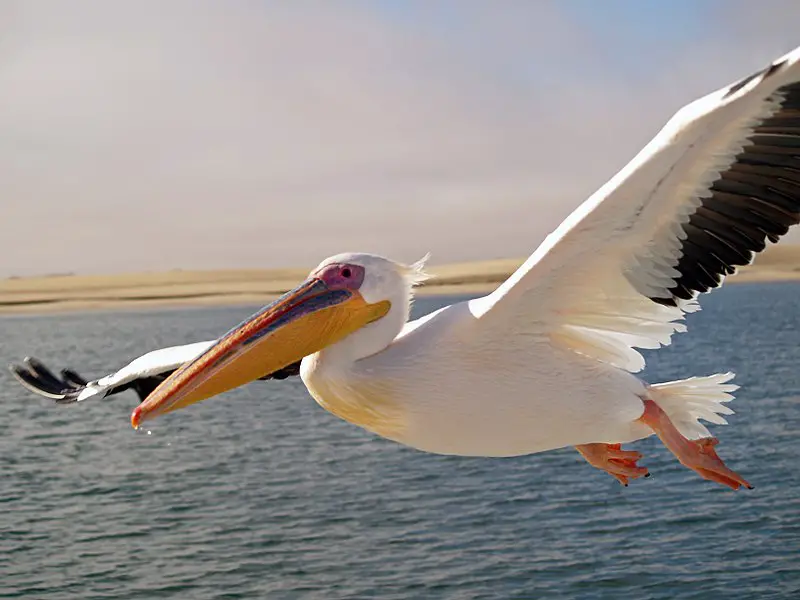
Pelicans are a large water bird and form part of the family Pelecanidae. They have long beaks, allowing them to scoop up prey from both land and sea with ease.
Their most distinctive feature is their huge throat pouch which they use to drain water before swallowing their food.
Most pelican species have predominantly pale plumage however exceptions such as the brown and Peruvian pelicans exhibit darker colouring.
The bill, face skin and pouch of all Pelican species become brightly coloured during breeding season in order to attract mates.
Pelicans can often live up to 25 years due to the fact that they eat mostly fish which provides them with enough nutrients for longevity.
Scientific classification:
| Kingdom | Animalia |
| Phylum | Chordata |
| Class | Aves |
| Order | Pelecaniformes |
| Family | Pelecanidae |
| Genus | Pelecanus Linnaeus, 1758 |
Also Featured In: Birds You’ll Find in the Sea, Water Birds Live around Us
47. Crimson Rosella
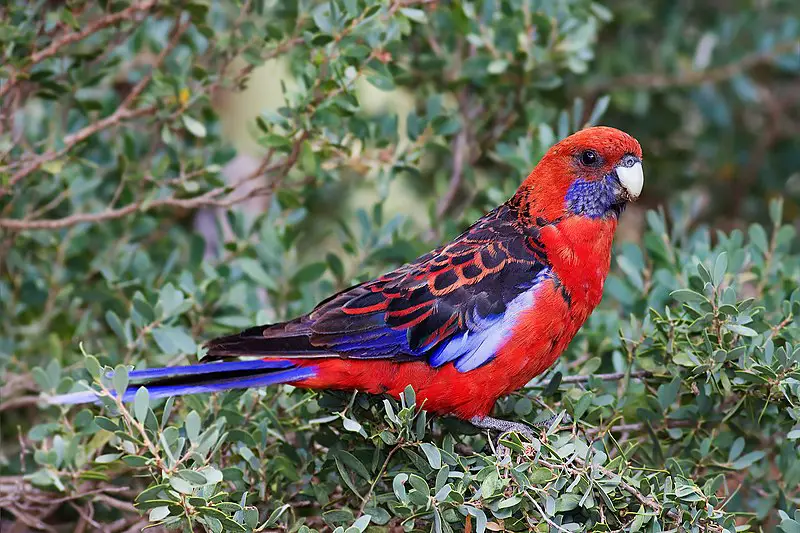
The Crimson Rosella is a beautiful parrot native to eastern and south eastern Australia which has been introduced to New Zealand and Norfolk Island.
It lives in mountain forests, gardens, woodlands or other open habitats such as farmland with trees.
This species was created when two separate species- the Yellow Rosella and Adelaide Rosella were combined together due to molecular studies showing them being closely related.
The Crimson Rosellas have bright red feathers on their wings and back with blue cheeks, forehead & tail while its underbelly is yellowish orange in colour.
They also have black bars across each wing & white patches near their tails making them an attractive sight for bird watchers.
Scientific classification:
| Kingdom | Animalia |
| Phylum | Chordata |
| Class | Aves |
| Order | Psittaciformes |
| Family | Psittaculidae |
| Genus | Platycercus |
| Species | P. elegans |
48. Bustard
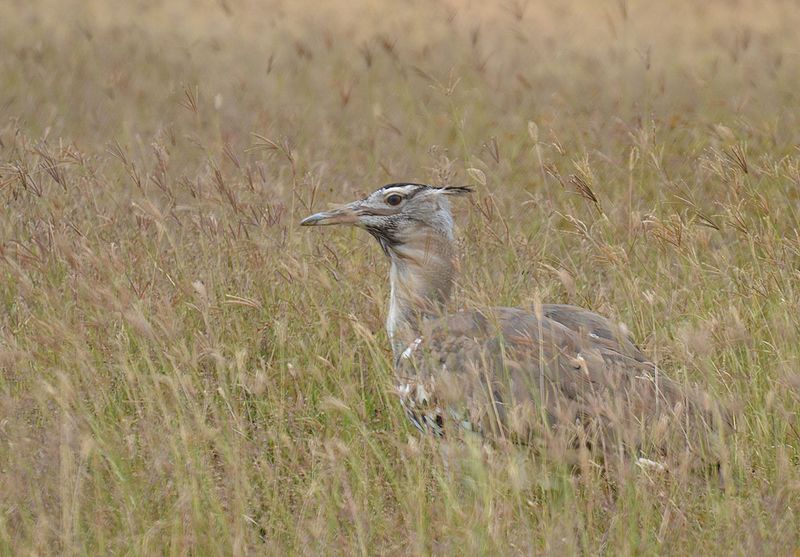
Bustards are large, terrestrial birds that inhabit dry grassland areas and the steppes of the Old World. They range from 40-150 cm in length and belong to the family Otididae.
Bustards have an omnivorous diet consisting of leaves, buds, seeds, fruit as well as small vertebrates and invertebrates.
These birds usually live a solitary life but can be seen gathering around water sources or food during certain times of year such as mating season.
Due to their large size they are vulnerable to predation by foxes or other animals which is why they tend to remain alert at all times.
When in open spaces while relying on camouflage for protection against predators when out in tall vegetation coverings.
Scientific classification:
| Kingdom | Animalia |
| Phylum | Chordata |
| Class | Aves |
| Clade | Otidimorphae |
| Order | Otidiformes Wagler, 1830 |
| Family | Otididae Rafinesque, 1815 |
49. Masked Lapwing
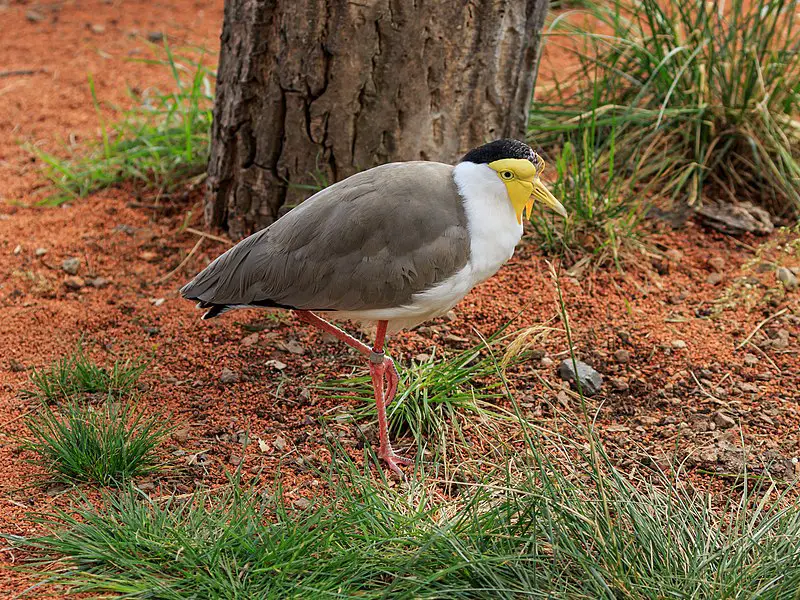
The Masked Lapwing is a large, distinctive bird that can be found in Australia, New Zealand and parts of Papua New Guinea.
It spends most of its time on the ground searching for food such as insects and worms, making it an important part of the local ecology.
It has several loud calls that are easily recognisable – from its ‘kwee-ep’ alarm call to its territorial ‘chi-wick’ call.
The Masked Lapwing is particularly known for swooping down when disturbed or threatened; however this behaviour serves to protect their nests with chicks during breeding season.
They inhabit open fields and grasslands which makes them easy to see if you’re lucky enough.
Scientific classification:
| Kingdom | Animalia |
| Phylum | Chordata |
| Class | Aves |
| Order | Charadriiformes |
| Family | Charadriidae |
| Genus | Vanellus |
| Species | V. miles |